
PAI
Personal AI Infrastructure for upgrading humans.
Stars: 317
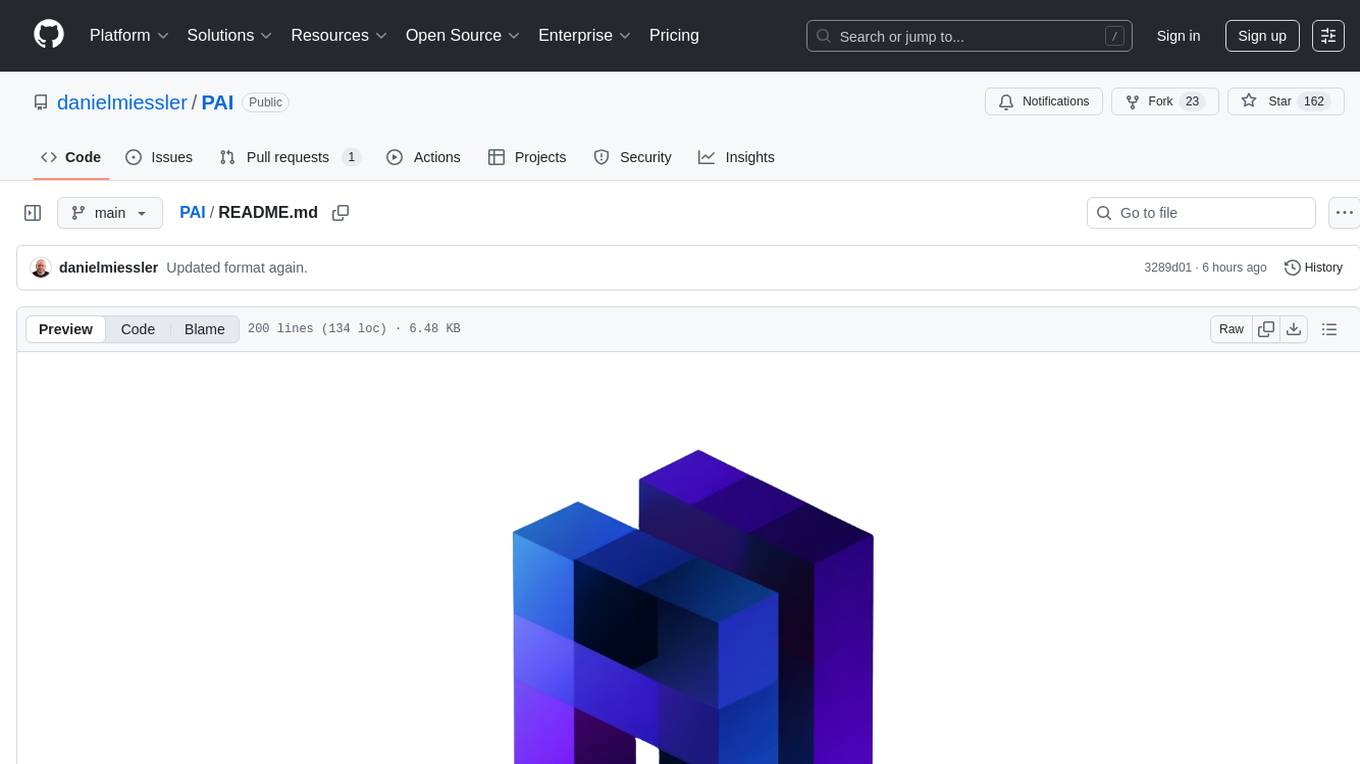
PAI is an open-source personal AI infrastructure designed to orchestrate personal and professional lives. It provides a scaffolding framework with real-world examples for life management, professional tasks, and personal goals. The core mission is to augment humans with AI capabilities to thrive in a world full of AI. PAI features UFC Context Architecture for persistent memory, specialized digital assistants for various tasks, an integrated tool ecosystem with MCP Servers, voice system, browser automation, and API integrations. The philosophy of PAI focuses on augmenting human capability rather than replacing it. The tool is MIT licensed and encourages contributions from the open-source community.
README:
[!TIP] 🎉 v0.2 Released! - Enhanced documentation and Human 3.0 integration
📅 September 25, 2025 - Voice Output Format & Bug Fix
- 🎯 Mandatory Format: Enforced structured response format for voice integration
- 🔊 Voice System: Fixed voice notification system breaking due to inconsistent output
- 🐛 Field Name Fix: Fixed stop-hook.ts sending wrong field names (
text/voiceId→message/voice_id) - 📋 Response Structure: All responses now use mandatory emoji headers with COMPLETED line
- 🪝 Hook Integration: COMPLETED line properly triggers voice notifications with correct field names
- ⚡ Consistency: Format applies to all responses, even simple answers
- 📝 Documentation: Added comprehensive voice-system.md documentation
- 📝 Context Updates: Updated both local and PAI CLAUDE.md files with strict enforcement
📅 September 25, 2025 - DA Environment Variable
- 🤖 DA Variable: Separated Digital Assistant name and color configuration
- 🎨 DA_COLOR Variable: Color now configurable via
DA_COLORenvironment variable - 📝 Clean Separation:
DAhandles the name,DA_COLORhandles the display color - 🎨 Color Options: purple (default), blue, green, cyan, magenta, yellow, red, orange
- ⚙️ Configuration: Add to
.zshrc:export DA="YourAssistantName" # Defaults to "Assistant" export DA_COLOR="purple" # Choose your color
📅 September 22, 2025 - v0.2 Release
- 🔗 Human 3.0: Added link to projects fit together blog post
- 📊 Badges: Fixed purple color and stats display issues
- 📝 Documentation: Improved table formatting and structure
- ✨ Polish: Enhanced README readability and navigation
- 🔧 Fixes: Minor formatting and display improvements
📅 September 21, 2025 - v0.1 Release
- 🎉 Release: Published v0.1 - Initial public release
- 🔒 Voice: Hardened the voice server
- 🏠 Portability: PAI_HOME support eliminates hardcoded paths
- 📚 Docs: Comprehensive documentation under
~/.claude/documentation/ - 🔌 Dynamic: MCP detection via
settings.json - 🏗️ Architecture: Complete system documentation with examples
📅 Previous Updates
September 20, 2025
- 🗣️ Added
/voice-serverwith ElevenLabs integration - 🔧 Fixed hardcoded path issues
- 🪝 Working on missing hooks
September 12, 2025
- 🧠 Dynamic resource loading system
- ⚡ Submit-user-hook for context loading
- 🗺️ Dynamic routing via load-dynamic-requirements
Core Mission: Augment humans with AI capabilities so they can survive and thrive in a world full of AI.
It doesn't matter how powerful AI becomes if it's not in the hands of everyone on Earth.
Right now, AI is trapped behind corporate APIs, expensive subscriptions, and complex interfaces that only developers can use. Meanwhile, billions of people who could benefit from AI augmentation—artists, teachers, small business owners, researchers, parents—are left behind.
PAI exists to solve this. This project's goal is to give the most powerful AI capabilities, in the form of a complete platform, to everyone on Earth. Not just the tech elite. Not just the wealthy. Everyone.
graph TB
You[👤 You] --> PAI[🧠 PAI/Kai]
PAI --> Work[💼 Work]
PAI --> Life[🏠 Life]
Work --> Blog[📝 write-blog]
Work --> News[📊 get-newsletter-stats]
Work --> Site[🌐 get-site-analytics]
Work --> Consult[💼 create-consulting-document]
Life --> Finance[💰 answer-finance-question]
Life --> Memory[🔍 get-life-log]
Life --> Alert[🔔 send-text-alert]
Life --> Health[🏥 track-health-metrics]
Blog --> Output[✨ Augmented Output]
News --> Output
Site --> Output
Consult --> Output
Finance --> Output
Memory --> Output
Alert --> Output
Health --> Output
style You fill:#24283b,stroke:#7aa2f7,stroke-width:2px,color:#c0caf5
style PAI fill:#1a1b26,stroke:#bb9af7,stroke-width:3px,color:#c0caf5
style Work fill:#24283b,stroke:#9ece6a,stroke-width:2px,color:#c0caf5
style Life fill:#24283b,stroke:#ff9e64,stroke-width:2px,color:#c0caf5
style Output fill:#1a1b26,stroke:#f7768e,stroke-width:3px,color:#c0caf5PAI is an open-source, full personal AI platform that's completely agnostic to who you are and what you're trying to accomplish.
Think of PAI as your personal AI that actually knows you—all your projects, your style, your data—and can handle anything you throw at it. Whether you're an artist transitioning to independence, a founder building a company, or someone managing complex health needs, PAI becomes whatever you need it to be.
PAI is part of the journey toward Human 3.0—where humans are augmented by AI to amplify their capabilities.
📖 Learn how PAI fits into the Human 3.0 vision
|
Finance Intelligence
Memory & Conversations
Health Tracking
|
Content Creation
Business Analytics
Development
|
Knowledge Capture
Communication
Productivity
|
This system is designed from the very beginning to be available to anybody and to grow and scale with you throughout your life.
- 🔓 Open Framework: No vendor lock-in, complete transparency, you own everything
- 🌍 Universal: Works for anyone, anywhere, in any profession or life situation
- 🤖 Platform Independent: Core structure works with Claude, GPT, Gemini, or any AI platform
- 🧠 Persistent Memory: Your AI remembers every context, project, and conversation
- 🎯 Task Agnostic: From writing a blog to tracking medical data to running a business
- 📁 Plain Text: All configuration in human-readable files you can edit and understand
- 🔌 Extensible: Add your own commands, agents, and integrations
📖 Read the full technical deep-dive on PAI
graph TD
User[👤 You] --> Hooks[🪝 Dynamic Hooks]
Hooks --> UFC[📁 UFC Context System]
Hooks --> Commands[⚡ Custom Commands]
UFC --> Projects[🧠 Projects]
UFC --> Life[🏠 Life Context]
UFC --> Work[💼 Work Context]
Commands --> MCPs[🔌 MCP Servers]
Commands --> Agents[🤖 AI Agents]
Commands --> APIs[🌐 API Integrations]
MCPs --> Playwright[🎭 Browser Automation]
MCPs --> Stripe[💳 Payment Processing]
MCPs --> Analytics[📊 Analytics]
Agents --> Output[✨ Augmented Actions]
APIs --> Output
MCPs --> Output
style User fill:#1f2937,stroke:#10b981,stroke-width:2px,color:#e5e7eb
style Hooks fill:#111827,stroke:#8b5cf6,stroke-width:2px,color:#e5e7eb
style Output fill:#111827,stroke:#ef4444,stroke-width:2px,color:#e5e7eb
|
Features:
|
[!NOTE] These are examples from my setup. Your PAI will have completely different commands based on YOUR unique needs. The possibilities are infinite!
|
💼 Professional:
|
🏠 Personal:
|
🚀 60+ commands ready to use out of the box
[!IMPORTANT] These agents are examples. You'll create your own specialized agents for YOUR specific workflows - artists might have creative agents, doctors might have diagnostic agents, teachers might have curriculum agents. The system adapts to YOU.
| Agent | Purpose | Tools | Use Case |
|---|---|---|---|
| 🔍 Researcher | Deep web research | WebSearch, WebFetch | Information gathering |
| ⚙️ Engineer | Production code | Testing, Debugging | Software development |
| 🎨 Designer | UX/UI design | Figma, shadcn/ui | Interface creation |
| 🔒 Pentester | Security testing | Nmap, Burp | Vulnerability assessment |
| 🏗️ Architect | System design | Diagrams, PRDs | Technical planning |
Enhanced with:
- 🎙️ ElevenLabs voice synthesis
- ⚡ Task parallelization
- 🔌 Deep tool integration
|
📥 Context Loading Hooks:
|
🔧 Integration Hooks:
|
|
🌐 Browser & Testing
|
💳 Financial
|
📊 Analytics
|
💬 Communication
|
[!NOTE] PAI was originally built with Claude Code, but the architecture supports any AI platform (GPT, Gemini, etc.) Requires Bun JavaScript runtime for the current implementation.
# Install Bun (JavaScript runtime)
brew install oven-sh/bun/bun
# Get Claude Code (AI interface)
# Visit: https://claude.ai/code# Clone the PAI repository
git clone https://github.com/danielmiessler/PAI.git
cd PAI
# Note: .claude directory is hidden by default
ls -la # See all files including .claude# Copy environment template
cp .env.example ~/.env
# Add your API keys (optional but recommended)
vim ~/.env
# Add: ELEVENLABS_API_KEY="your_key_here"
# Add: OPENAI_API_KEY="your_key_here"# Add to your shell config (~/.zshrc or ~/.bashrc)
export PAI_HOME="$HOME"
# Reload your shell configuration
source ~/.zshrc # or source ~/.bashrc# Navigate to PAI directory
cd ~/.claude
# Optional: Start voice server for audio notifications
cd voice-server && ./install.sh && ./start.sh
# Open Claude Code and start using PAI!
# Your personal AI infrastructure is ready 🚀# Required
PAI_HOME="/path/to/pai" # PAI installation directory
# Optional
ELEVENLABS_API_KEY="your_key" # Voice synthesis
OPENAI_API_KEY="your_key" # GPT integration
PORT="8888" # Voice server port| 📖 Guide | 🎯 Purpose | ⏱️ Time |
|---|---|---|
| Quick Start | Get up and running | 5 min |
| Architecture | Understand the system | 10 min |
| SECURITY.md | Security guidelines | 5 min |
| Voice Server | Enable voice interaction | 10 min |
| Commands Directory | Browse all commands | 15 min |
[!IMPORTANT] These are examples from my personal PAI setup. Your system will have completely different commands based on YOUR unique needs, workflows, and goals. The beauty of PAI is that it becomes whatever YOU need it to be.
📊 Newsletter Performance# Track newsletter metrics in real-time
get-newsletter-stats
# Returns subscriber growth, open rates, top content🚀 Startup Dashboard# Monitor all key metrics
get-site-analytics # Traffic and conversions
get-finances-state # Revenue tracking
add-linear-ticket # Development velocity🔍 Code Security# Security automation
check-for-sensitive --scan all
design-review --security-focus
browser-tools-setup --headers🔌 API Infrastructure# Personal API management
update-daemon --endpoints
create-cloudflare-mcp-server
update-tools-context --integrations
startup-context-load📝 Blog Pipeline# End-to-end content creation
web-research "emerging AI trends"
extract-knowledge --key-points
write-blog --style personal --length 1500
enhance-content --seo --readability
publish-blog --schedule tomorrow🎨 Visual Content# Create stunning visualizations
create-d3-visualization --data metrics.json
create-custom-image "futuristic AI assistant"
create-mermaid-visualization --type flowchart |
📉 Expense Analysis# Instant financial insights
answer-finance-question "monthly utilities average?"
answer-finance-question "subscription spending?"
process-finances-data --categorize --visualize📈 Financial Planning# Comprehensive financial overview
get-finances-state
prepare-finances-dashboard
push-finances-state --notify🔍 Meeting Recall# Never forget a conversation
get-life-log "investor meeting last week"
get-life-log "product roadmap decisions"
query-context "action items from standup"📚 Knowledge Building# Build your second brain
capture-learning --source conference
extract-knowledge --summarize
learn-from-iterations --improve
query-context "machine learning notes"툿 Morning Automation# Start your day right
get-life-log "yesterday's highlights"
query-context "today's priorities"
send-text-alert "heading to office"
reset-visitor-peak # Reset daily counters📧 Smart Communication# Intelligent outreach
send-email --template followup
send-discord-alert --channel team
add-links --resource documentation
update-public-content |
🎨 Creative Portfolio# Manage artistic work
track-project-progress "oil painting series"
generate-artist-statement --style contemporary
update-portfolio-website --new-pieces
schedule-gallery-submission --deadline friday📷 Photography Business# End-to-end photography workflow
process-shoot-metadata --wedding-2024-09
generate-client-gallery --password-protected
send-invoice --client johnson-wedding
backup-raw-files --cloud-storage🎤 Music Production# Creative music workflow
track-song-ideas --voice-memo-to-text
generate-chord-progressions --key-of-c
schedule-studio-time --next-available
export-stems --for-mixing🏋️ Client Management# Wellness practice automation
track-client-progress --weekly-checkin
generate-meal-plans --dietary-restrictions
send-motivation-message --personalized
schedule-follow-up --in-two-weeks🔬 Research Pipeline# Academic workflow
search-literature --keywords "machine learning ethics"
organize-citations --zotero-import
generate-literature-review --outline
track-experiment-results --statistical-analysis🏡 Property Management# Real estate automation
analyze-market-trends --neighborhood-data
generate-property-reports --comparative-analysis
schedule-showings --calendar-optimization
send-client-updates --weekly-digest |
PAI is MIT licensed. See LICENSE for details.
"Humans are what matter. AI is only as useful as it is to people. A system like this is need to level the field with AI and help us get to Human 3.0."
Created by Daniel Miessler
📧 Newsletter • 📝 Blog • 💼 LinkedIn • 🎬 YouTube

For Tasks:
Click tags to check more tools for each tasksFor Jobs:
Alternative AI tools for PAI
Similar Open Source Tools

PAI
PAI is an open-source personal AI infrastructure designed to orchestrate personal and professional lives. It provides a scaffolding framework with real-world examples for life management, professional tasks, and personal goals. The core mission is to augment humans with AI capabilities to thrive in a world full of AI. PAI features UFC Context Architecture for persistent memory, specialized digital assistants for various tasks, an integrated tool ecosystem with MCP Servers, voice system, browser automation, and API integrations. The philosophy of PAI focuses on augmenting human capability rather than replacing it. The tool is MIT licensed and encourages contributions from the open-source community.
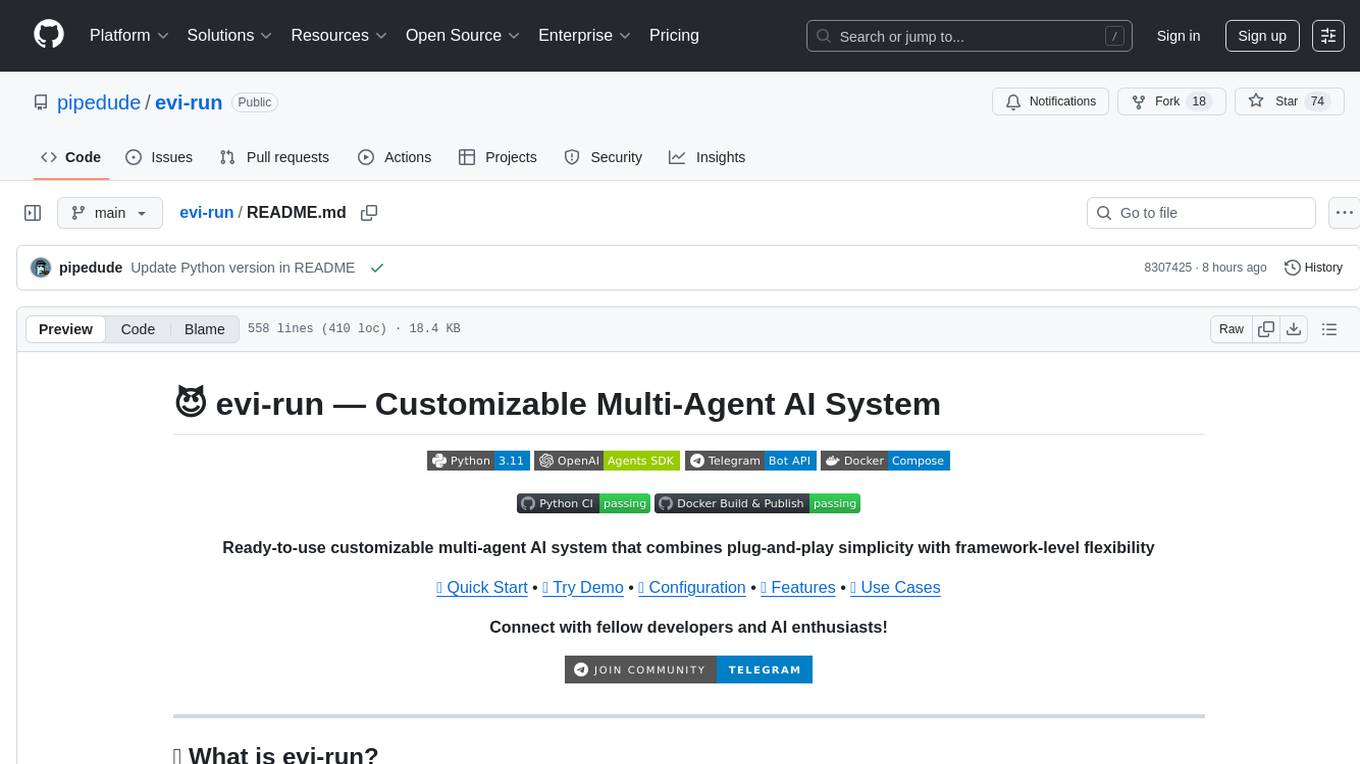
evi-run
evi-run is a powerful, production-ready multi-agent AI system built on Python using the OpenAI Agents SDK. It offers instant deployment, ultimate flexibility, built-in analytics, Telegram integration, and scalable architecture. The system features memory management, knowledge integration, task scheduling, multi-agent orchestration, custom agent creation, deep research, web intelligence, document processing, image generation, DEX analytics, and Solana token swap. It supports flexible usage modes like private, free, and pay mode, with upcoming features including NSFW mode, task scheduler, and automatic limit orders. The technology stack includes Python 3.11, OpenAI Agents SDK, Telegram Bot API, PostgreSQL, Redis, and Docker & Docker Compose for deployment.
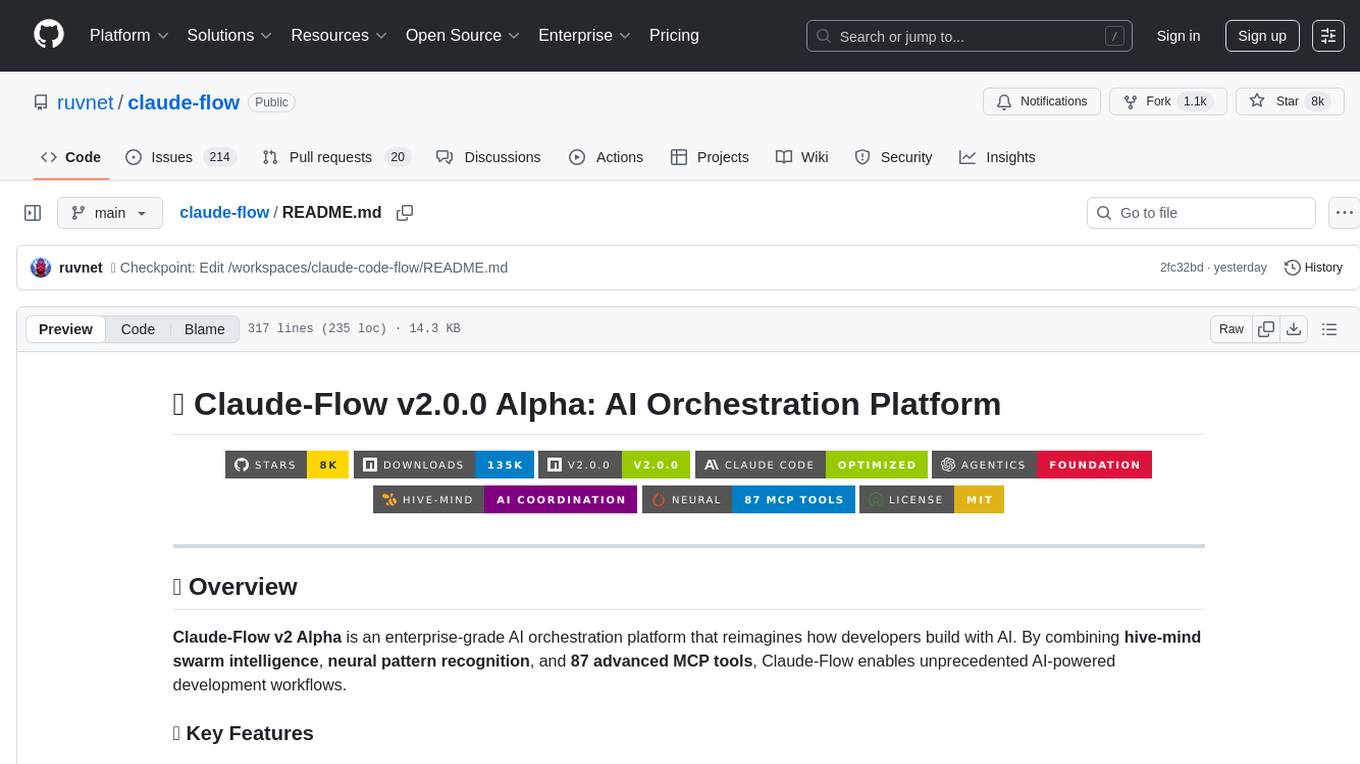
claude-flow
Claude-Flow is a workflow automation tool designed to streamline and optimize business processes. It provides a user-friendly interface for creating and managing workflows, allowing users to automate repetitive tasks and improve efficiency. With features such as drag-and-drop workflow builder, customizable templates, and integration with popular business tools, Claude-Flow empowers users to automate their workflows without the need for extensive coding knowledge. Whether you are a small business owner looking to streamline your operations or a project manager seeking to automate task assignments, Claude-Flow offers a flexible and scalable solution to meet your workflow automation needs.
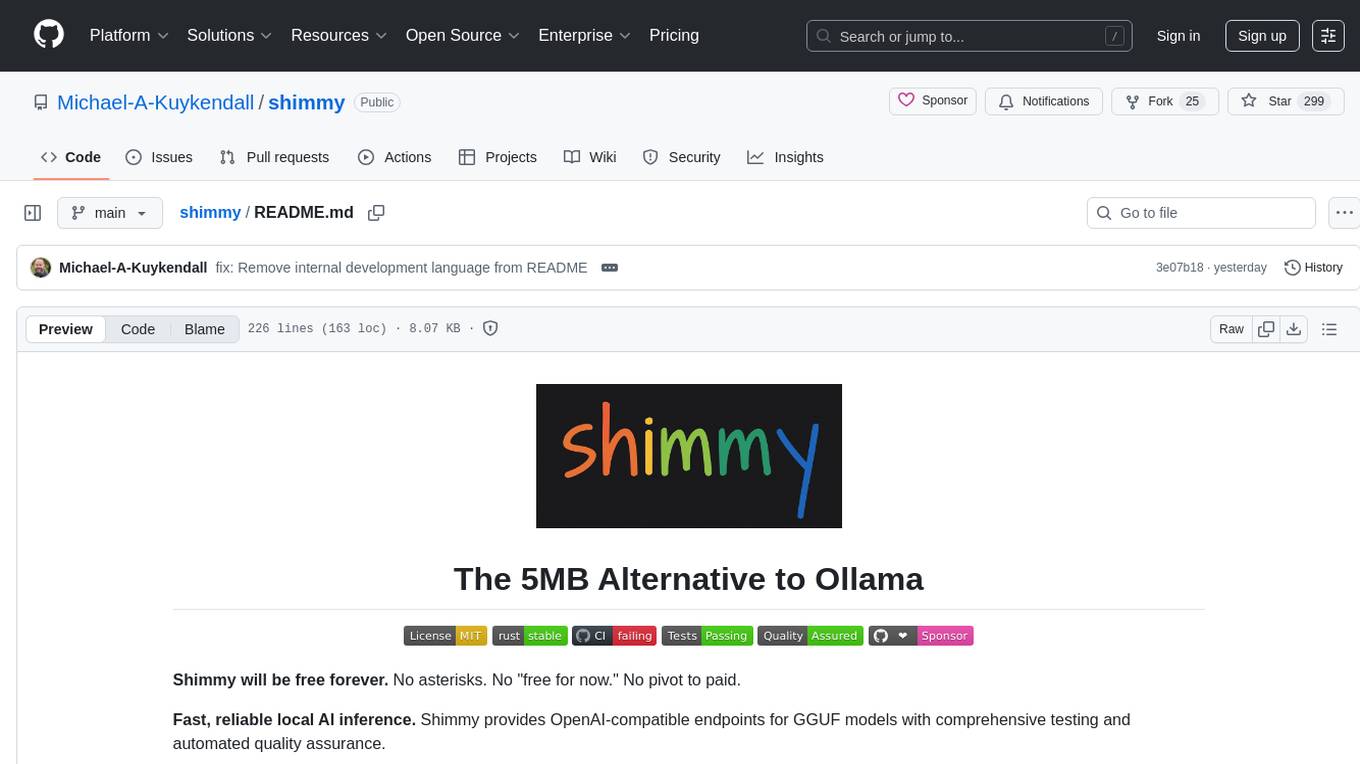
shimmy
Shimmy is a 5.1MB single-binary local inference server providing OpenAI-compatible endpoints for GGUF models. It offers fast, reliable AI inference with sub-second responses, zero configuration, and automatic port management. Perfect for developers seeking privacy, cost-effectiveness, speed, and easy integration with popular tools like VSCode and Cursor. Shimmy is designed to be invisible infrastructure that simplifies local AI development and deployment.
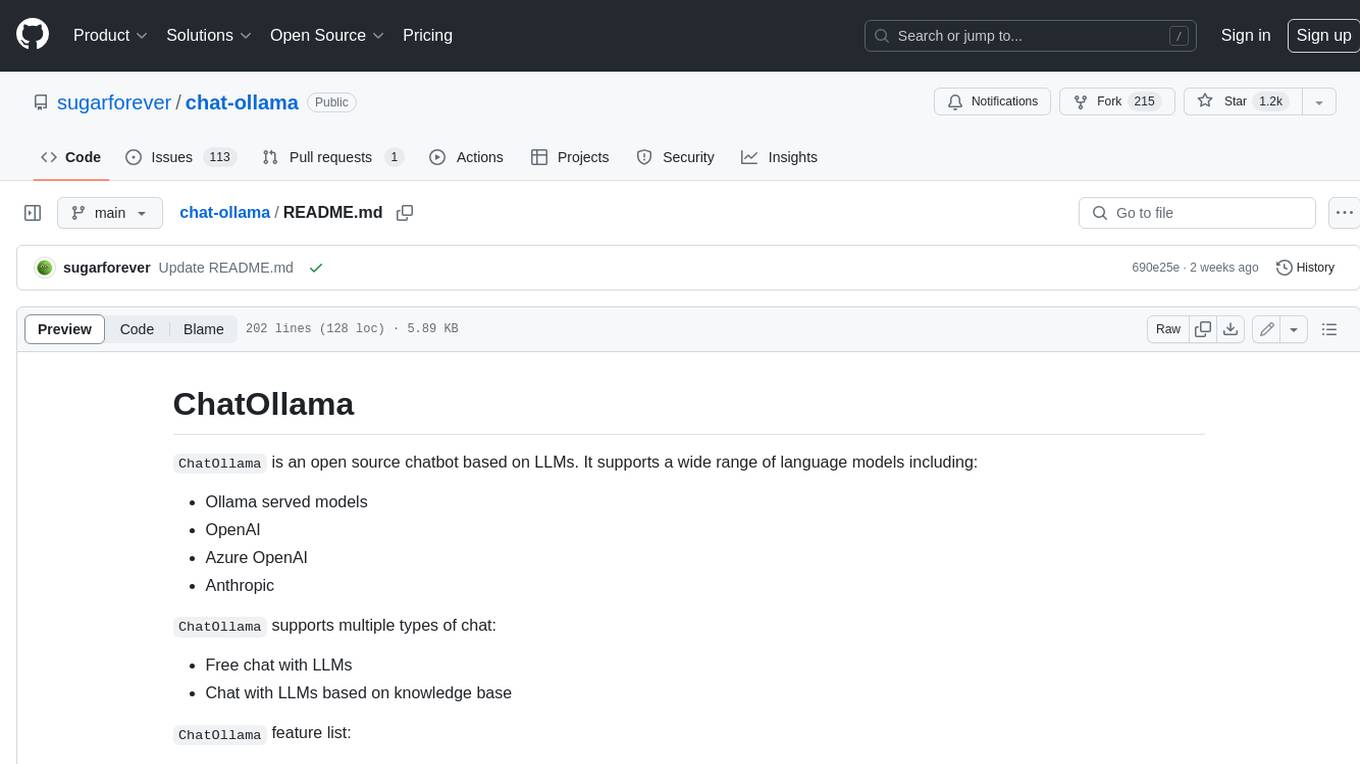
chat-ollama
ChatOllama is an open-source chatbot based on LLMs (Large Language Models). It supports a wide range of language models, including Ollama served models, OpenAI, Azure OpenAI, and Anthropic. ChatOllama supports multiple types of chat, including free chat with LLMs and chat with LLMs based on a knowledge base. Key features of ChatOllama include Ollama models management, knowledge bases management, chat, and commercial LLMs API keys management.
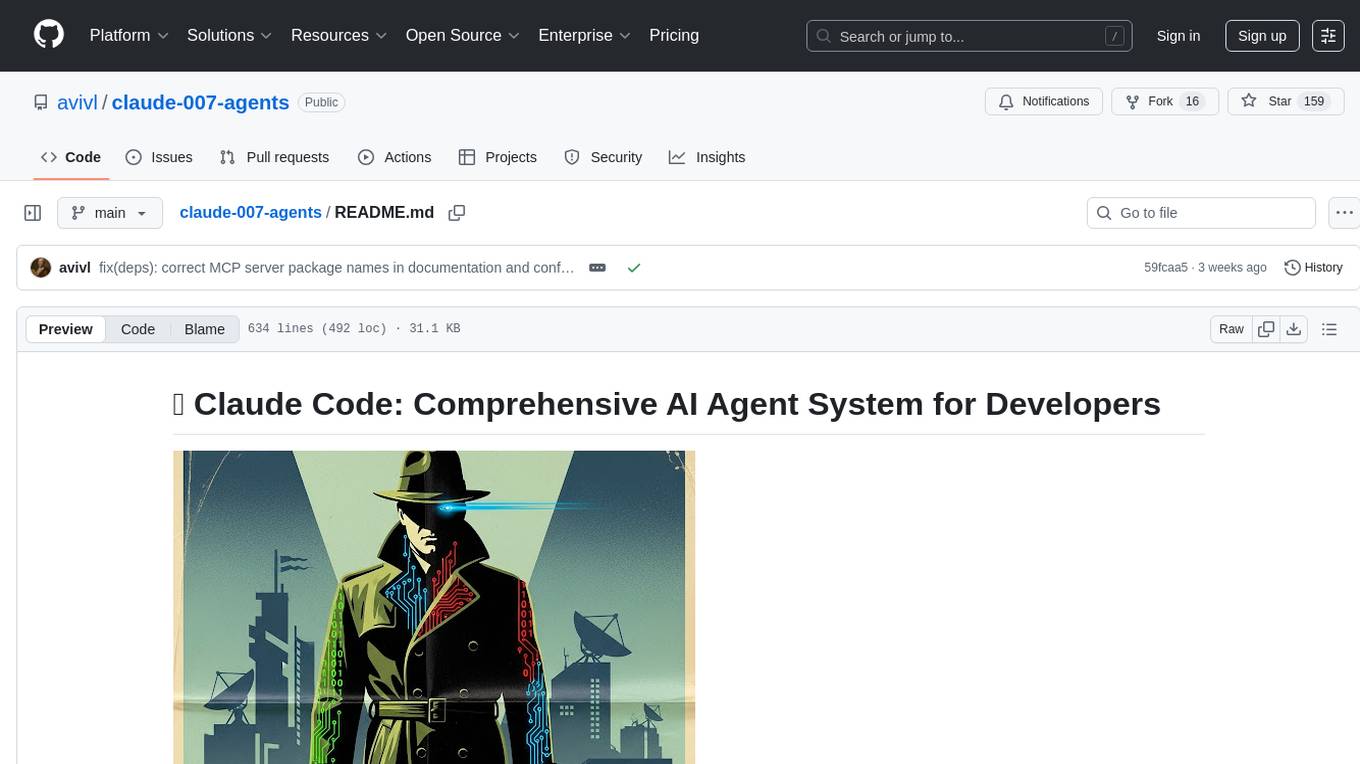
claude-007-agents
Claude Code Agents is an open-source AI agent system designed to enhance development workflows by providing specialized AI agents for orchestration, resilience engineering, and organizational memory. These agents offer specialized expertise across technologies, AI system with organizational memory, and an agent orchestration system. The system includes features such as engineering excellence by design, advanced orchestration system, Task Master integration, live MCP integrations, professional-grade workflows, and organizational intelligence. It is suitable for solo developers, small teams, enterprise teams, and open-source projects. The system requires a one-time bootstrap setup for each project to analyze the tech stack, select optimal agents, create configuration files, set up Task Master integration, and validate system readiness.
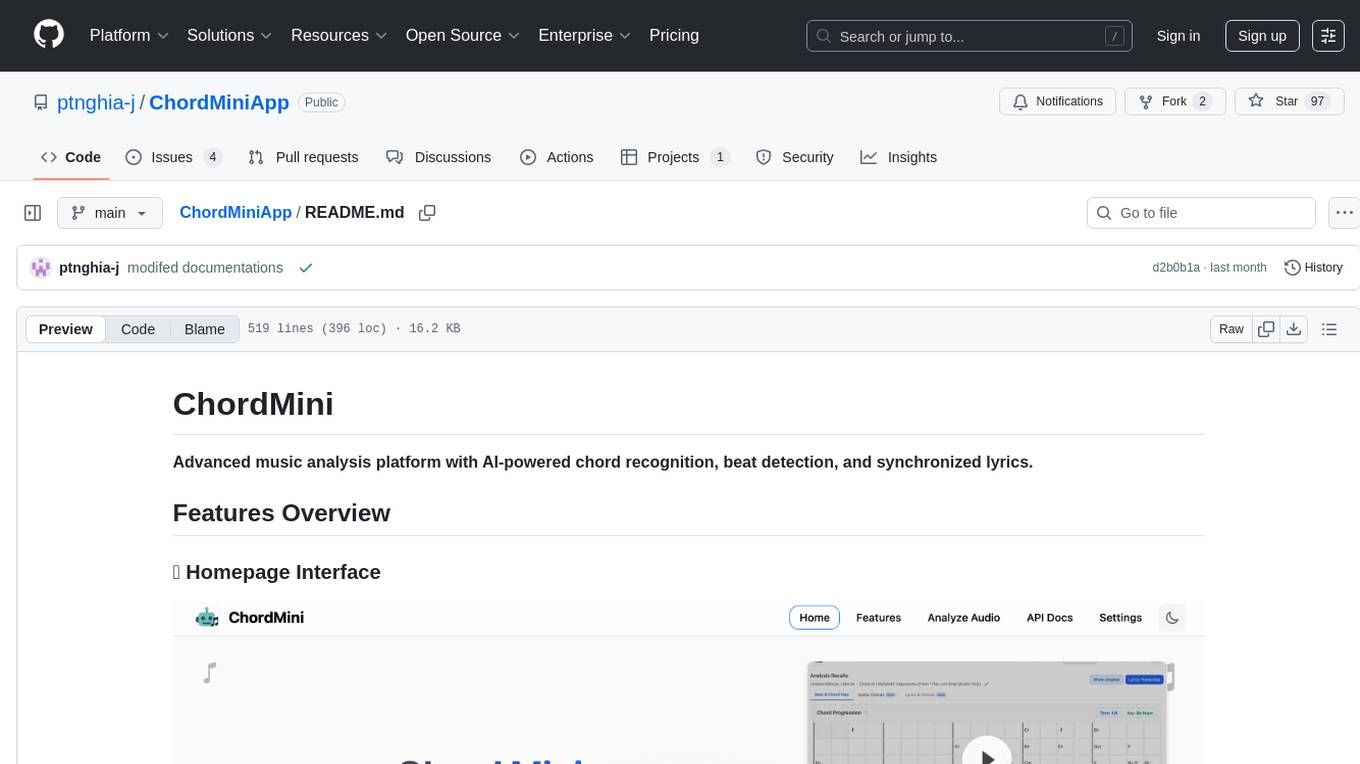
ChordMiniApp
ChordMini is an advanced music analysis platform with AI-powered chord recognition, beat detection, and synchronized lyrics. It features a clean and intuitive interface for YouTube search, chord progression visualization, interactive guitar diagrams with accurate fingering patterns, lead sheet with AI assistant for synchronized lyrics transcription, and various add-on features like Roman Numeral Analysis, Key Modulation Signals, Simplified Chord Notation, and Enhanced Chord Correction. The tool requires Node.js, Python 3.9+, and a Firebase account for setup. It offers a hybrid backend architecture for local development and production deployments, with features like beat detection, chord recognition, lyrics processing, rate limiting, and audio processing supporting MP3, WAV, and FLAC formats. ChordMini provides a comprehensive music analysis workflow from user input to visualization, including dual input support, environment-aware processing, intelligent caching, advanced ML pipeline, and rich visualization options.
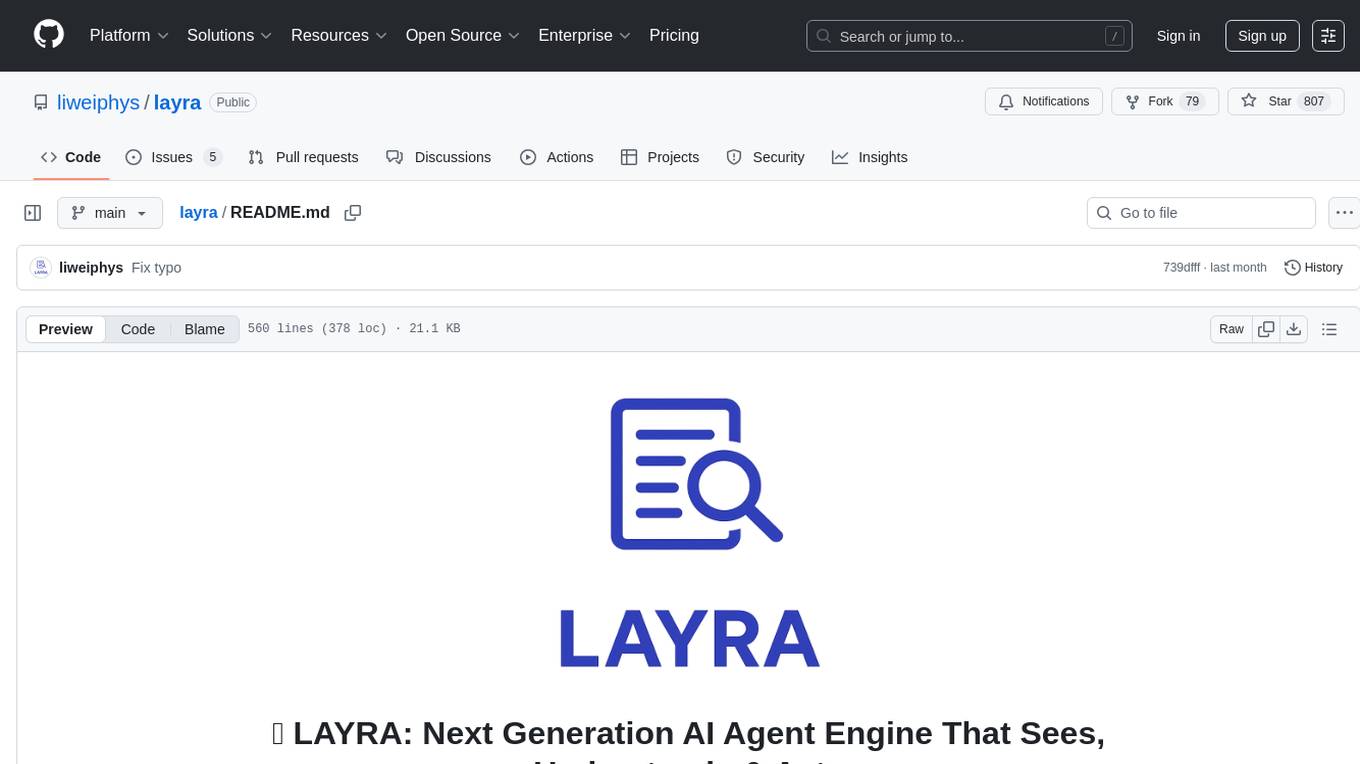
layra
LAYRA is the world's first visual-native AI automation engine that sees documents like a human, preserves layout and graphical elements, and executes arbitrarily complex workflows with full Python control. It empowers users to build next-generation intelligent systems with no limits or compromises. Built for Enterprise-Grade deployment, LAYRA features a modern frontend, high-performance backend, decoupled service architecture, visual-native multimodal document understanding, and a powerful workflow engine.
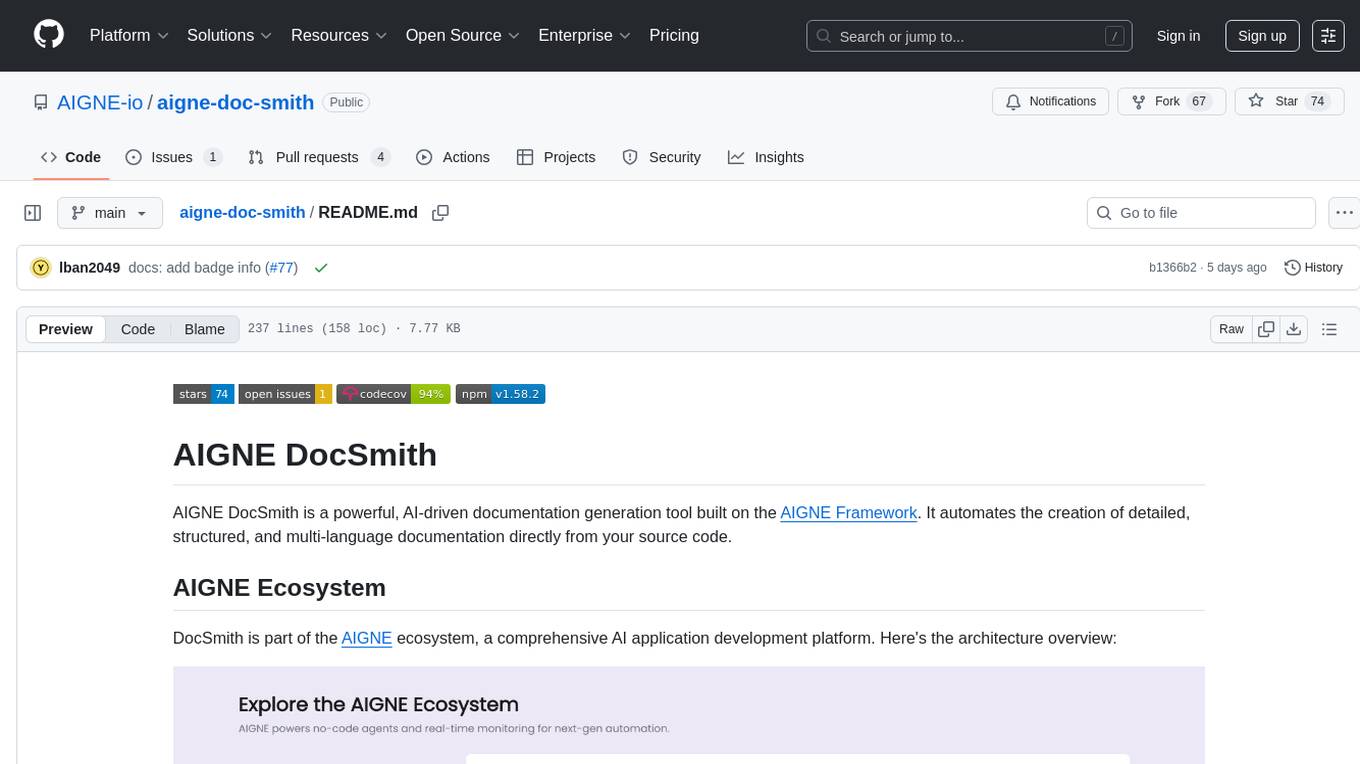
aigne-doc-smith
AIGNE DocSmith is a powerful AI-driven documentation generation tool that automates the creation of detailed, structured, and multi-language documentation directly from source code. It intelligently analyzes codebase to generate a comprehensive document structure, populates content with high-quality AI-powered generation, supports seamless translation into 12+ languages, integrates with AIGNE Hub for large language models, offers Discuss Kit publishing, automatically updates documentation with source code changes, and allows for individual document optimization.
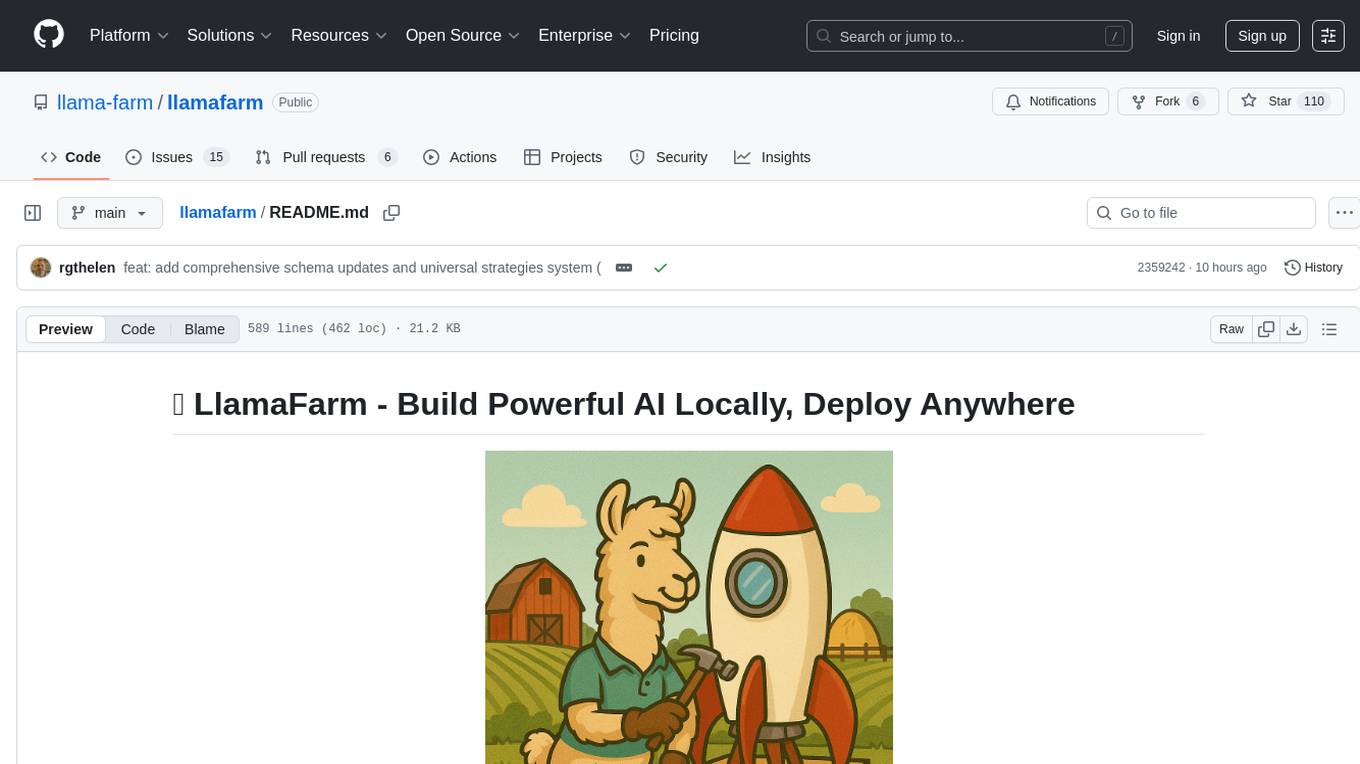
llamafarm
LlamaFarm is a comprehensive AI framework that empowers users to build powerful AI applications locally, with full control over costs and deployment options. It provides modular components for RAG systems, vector databases, model management, prompt engineering, and fine-tuning. Users can create differentiated AI products without needing extensive ML expertise, using simple CLI commands and YAML configs. The framework supports local-first development, production-ready components, strategy-based configuration, and deployment anywhere from laptops to the cloud.
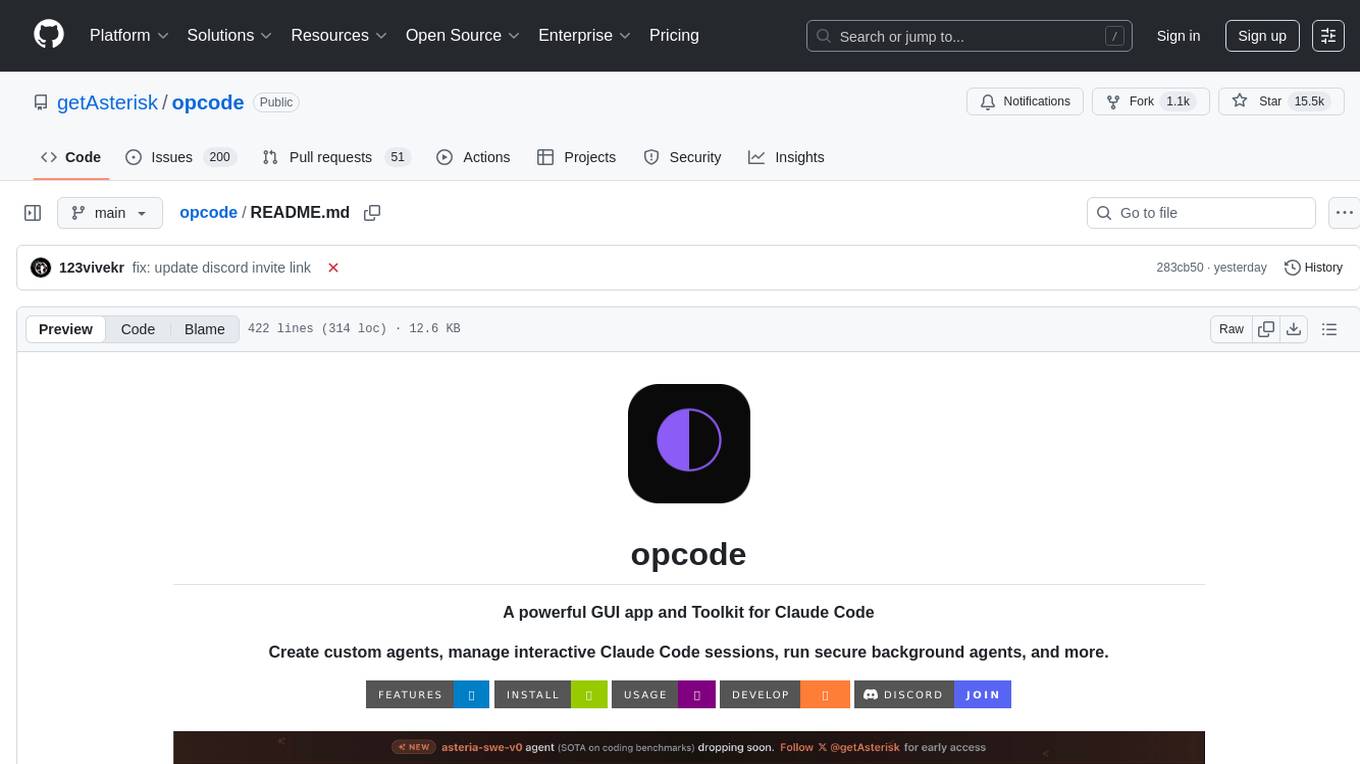
opcode
opcode is a powerful desktop application built with Tauri 2 that serves as a command center for interacting with Claude Code. It offers a visual GUI for managing Claude Code sessions, creating custom agents, tracking usage, and more. Users can navigate projects, create specialized AI agents, monitor usage analytics, manage MCP servers, create session checkpoints, edit CLAUDE.md files, and more. The tool bridges the gap between command-line tools and visual experiences, making AI-assisted development more intuitive and productive.
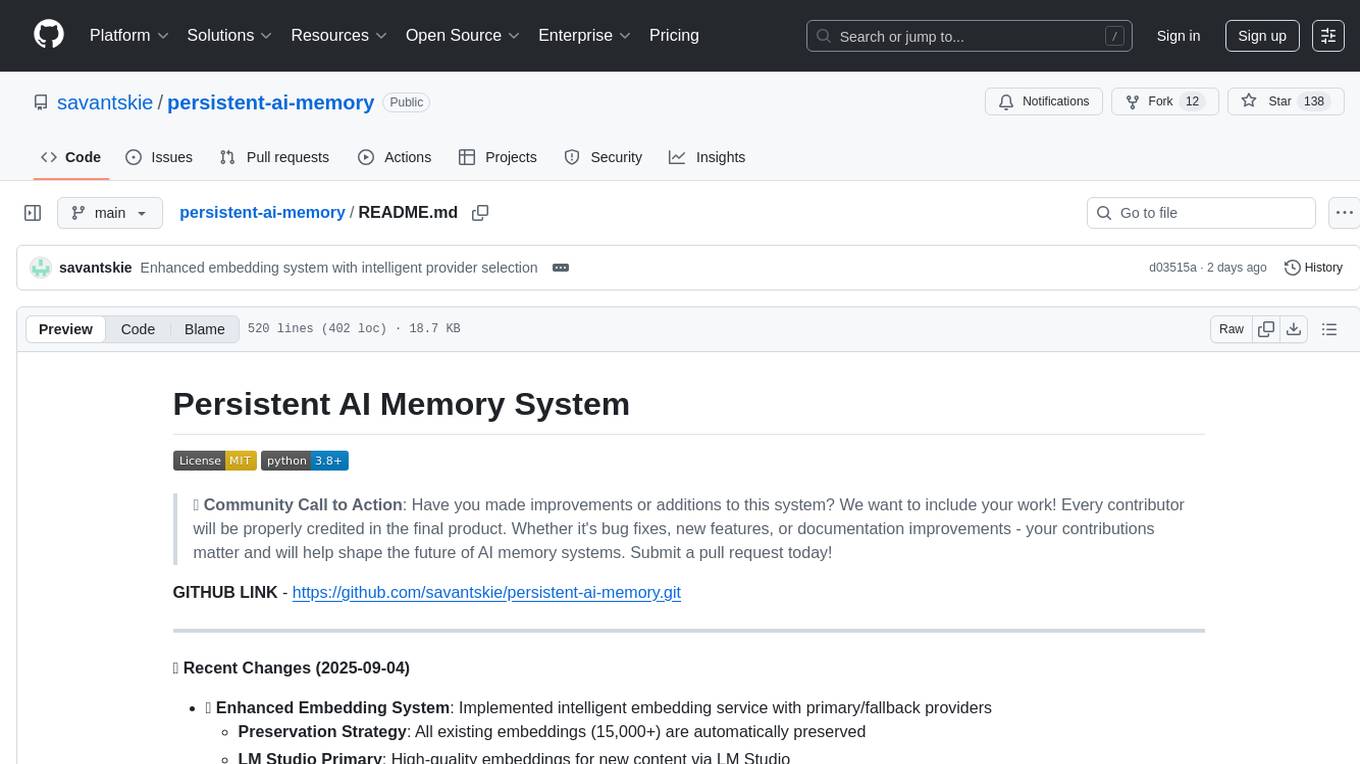
persistent-ai-memory
Persistent AI Memory System is a comprehensive tool that offers persistent, searchable storage for AI assistants. It includes features like conversation tracking, MCP tool call logging, and intelligent scheduling. The system supports multiple databases, provides enhanced memory management, and offers various tools for memory operations, schedule management, and system health checks. It also integrates with various platforms like LM Studio, VS Code, Koboldcpp, Ollama, and more. The system is designed to be modular, platform-agnostic, and scalable, allowing users to handle large conversation histories efficiently.
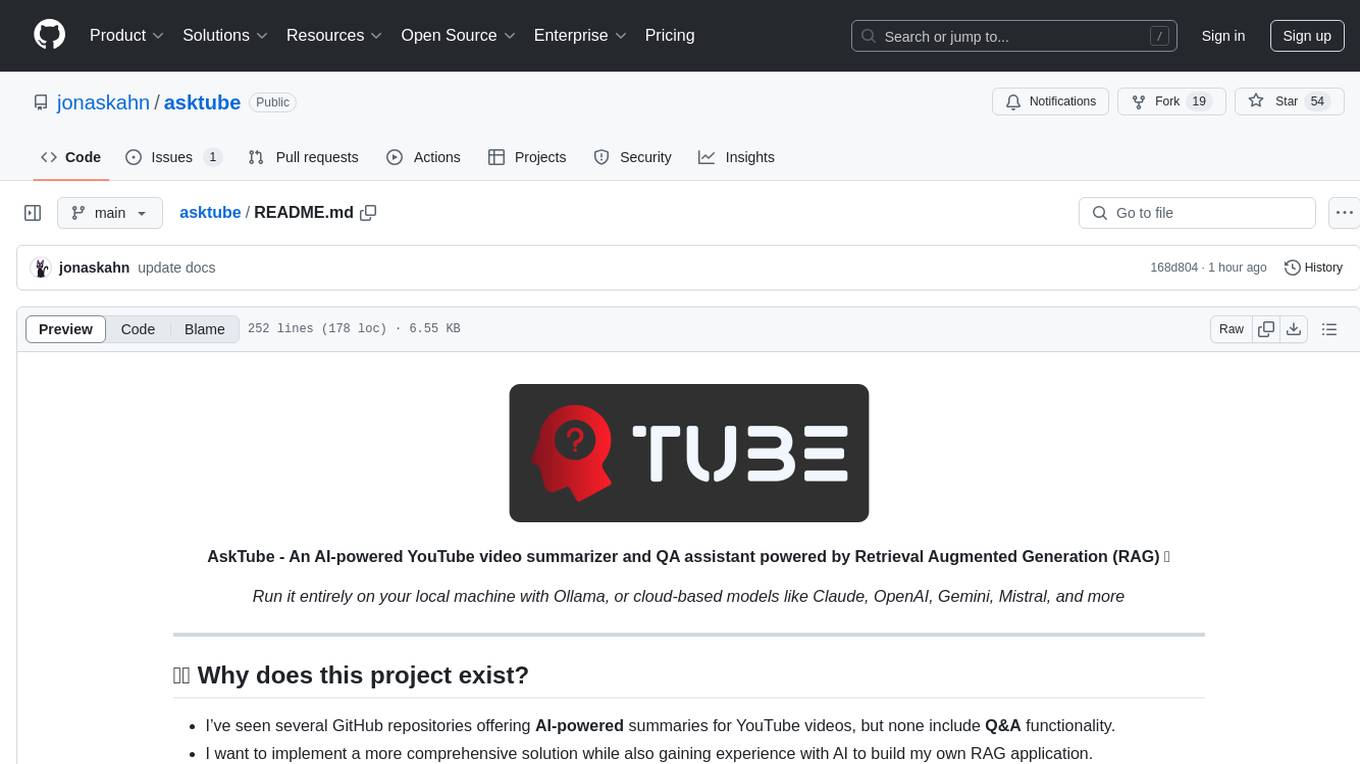
asktube
AskTube is an AI-powered YouTube video summarizer and QA assistant that utilizes Retrieval Augmented Generation (RAG) technology. It offers a comprehensive solution with Q&A functionality and aims to provide a user-friendly experience for local machine usage. The project integrates various technologies including Python, JS, Sanic, Peewee, Pytubefix, Sentence Transformers, Sqlite, Chroma, and NuxtJs/DaisyUI. AskTube supports multiple providers for analysis, AI services, and speech-to-text conversion. The tool is designed to extract data from YouTube URLs, store embedding chapter subtitles, and facilitate interactive Q&A sessions with enriched questions. It is not intended for production use but rather for end-users on their local machines.
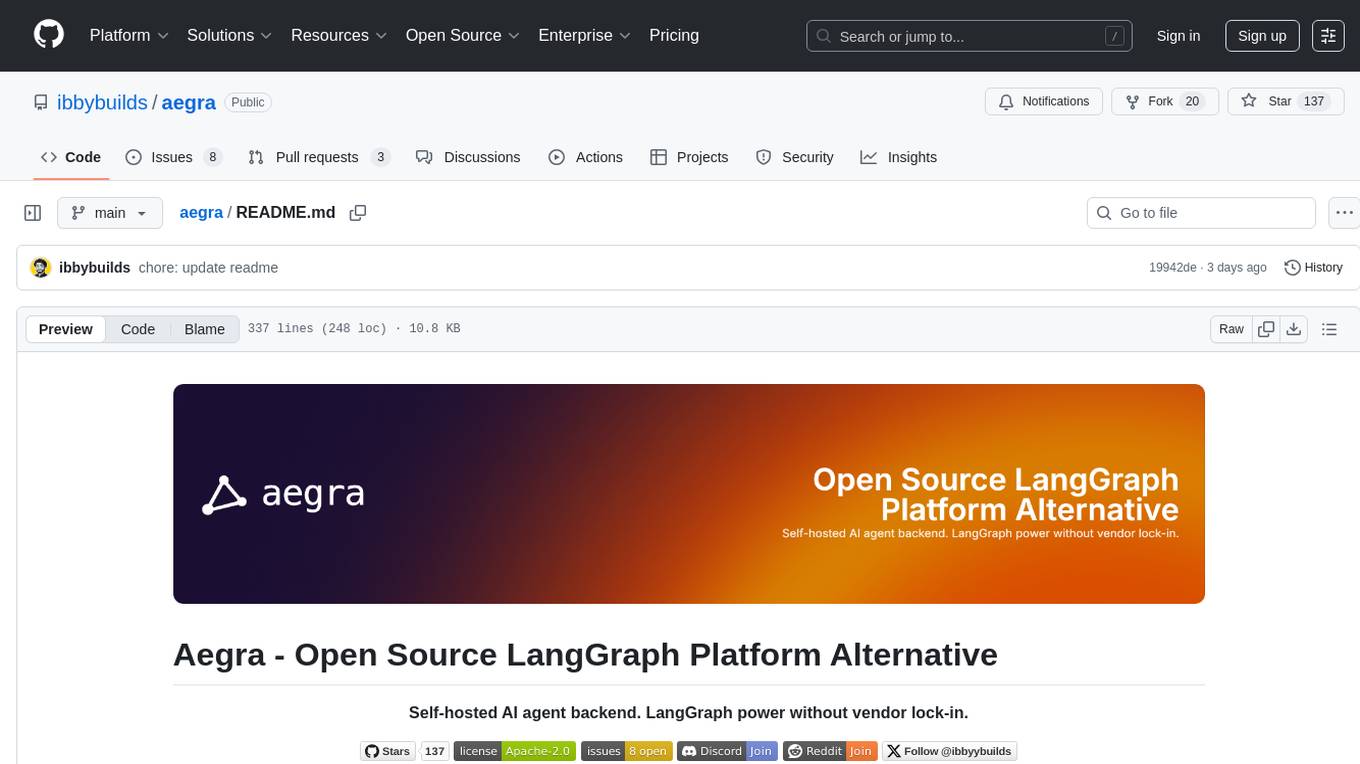
aegra
Aegra is a self-hosted AI agent backend platform that provides LangGraph power without vendor lock-in. Built with FastAPI + PostgreSQL, it offers complete control over agent orchestration for teams looking to escape vendor lock-in, meet data sovereignty requirements, enable custom deployments, and optimize costs. Aegra is Agent Protocol compliant and perfect for teams seeking a free, self-hosted alternative to LangGraph Platform with zero lock-in, full control, and compatibility with existing LangGraph Client SDK.
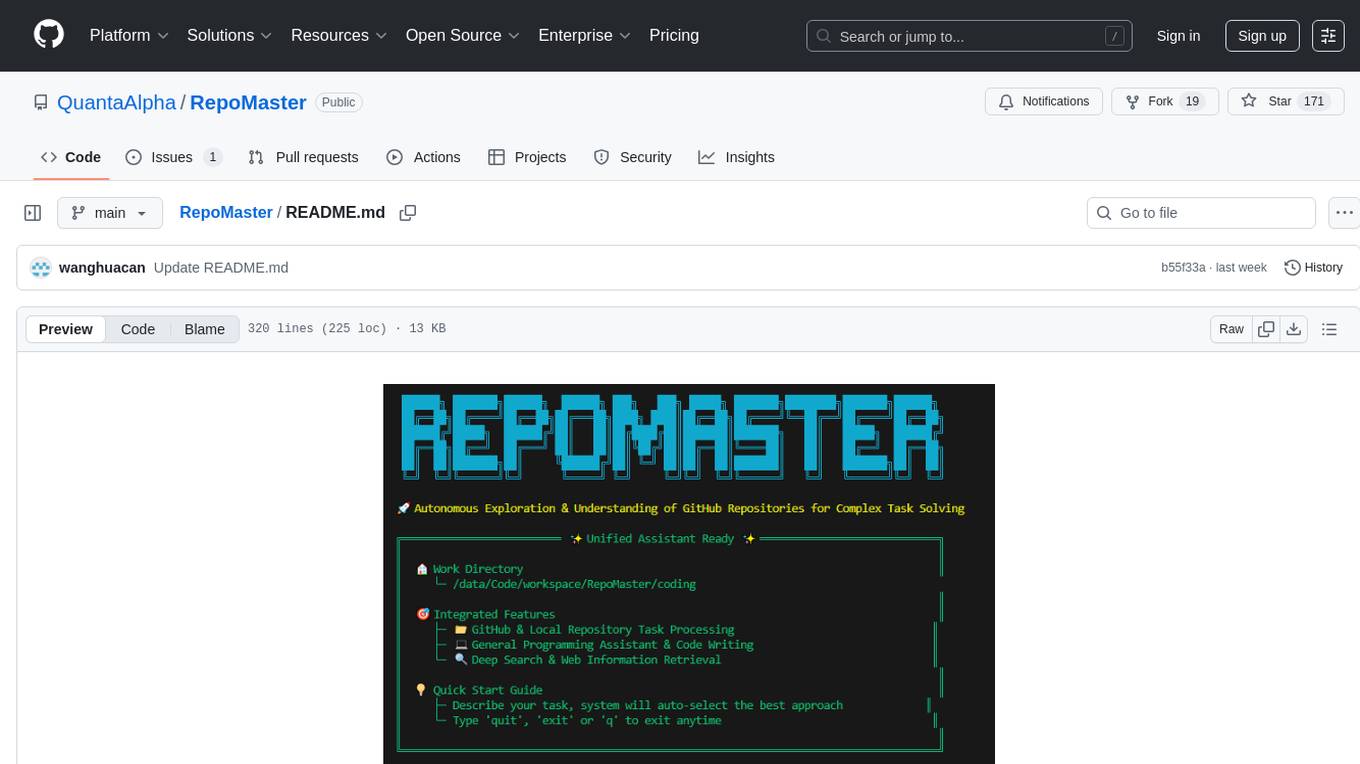
RepoMaster
RepoMaster is an AI agent that leverages GitHub repositories to solve complex real-world tasks. It transforms how coding tasks are solved by automatically finding the right GitHub tools and making them work together seamlessly. Users can describe their tasks, and RepoMaster's AI analysis leads to auto discovery and smart execution, resulting in perfect outcomes. The tool provides a web interface for beginners and a command-line interface for advanced users, along with specialized agents for deep search, general assistance, and repository tasks.
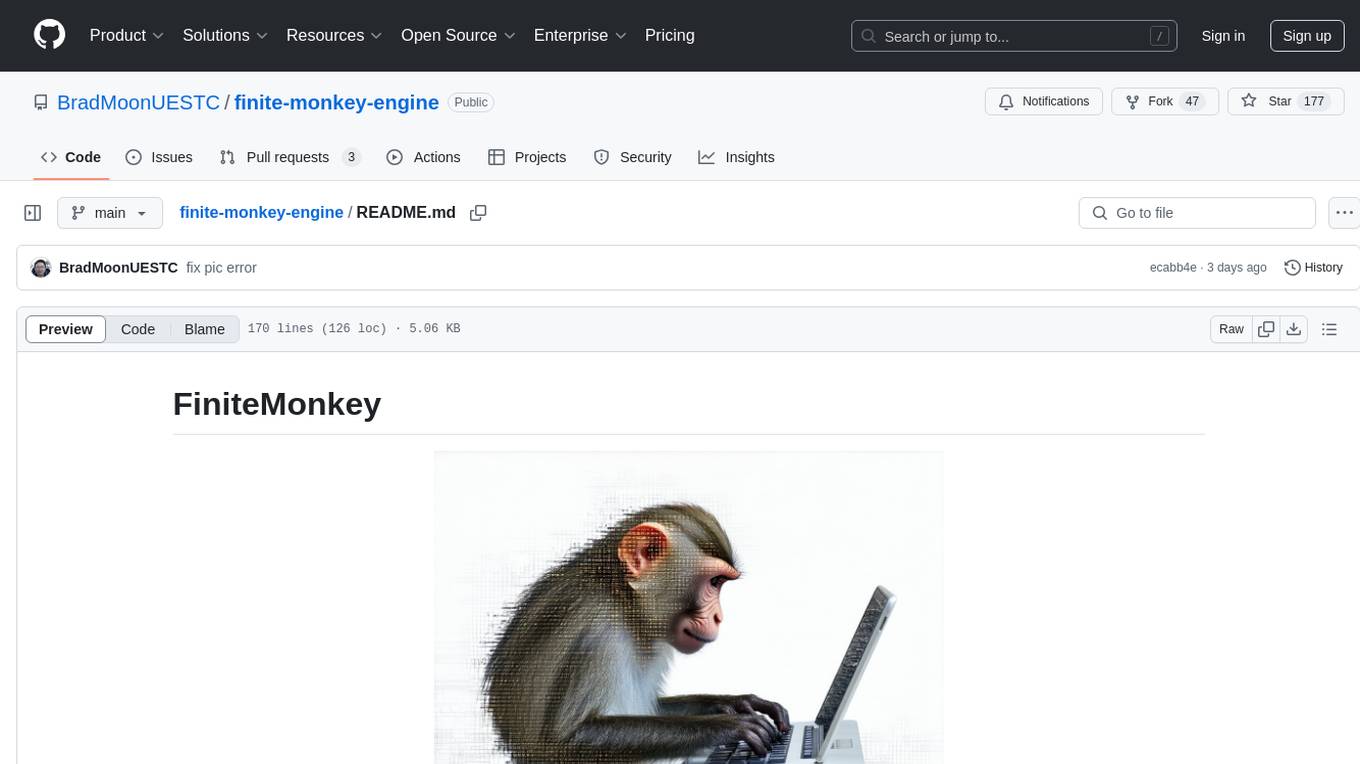
finite-monkey-engine
FiniteMonkey is an advanced vulnerability mining engine powered purely by GPT, requiring no prior knowledge base or fine-tuning. Its effectiveness significantly surpasses most current related research approaches. The tool is task-driven, prompt-driven, and focuses on prompt design, leveraging 'deception' and hallucination as key mechanics. It has helped identify vulnerabilities worth over $60,000 in bounties. The tool requires PostgreSQL database, OpenAI API access, and Python environment for setup. It supports various languages like Solidity, Rust, Python, Move, Cairo, Tact, Func, Java, and Fake Solidity for scanning. FiniteMonkey is best suited for logic vulnerability mining in real projects, not recommended for academic vulnerability testing. GPT-4-turbo is recommended for optimal results with an average scan time of 2-3 hours for medium projects. The tool provides detailed scanning results guide and implementation tips for users.
For similar tasks

PAI
PAI is an open-source personal AI infrastructure designed to orchestrate personal and professional lives. It provides a scaffolding framework with real-world examples for life management, professional tasks, and personal goals. The core mission is to augment humans with AI capabilities to thrive in a world full of AI. PAI features UFC Context Architecture for persistent memory, specialized digital assistants for various tasks, an integrated tool ecosystem with MCP Servers, voice system, browser automation, and API integrations. The philosophy of PAI focuses on augmenting human capability rather than replacing it. The tool is MIT licensed and encourages contributions from the open-source community.
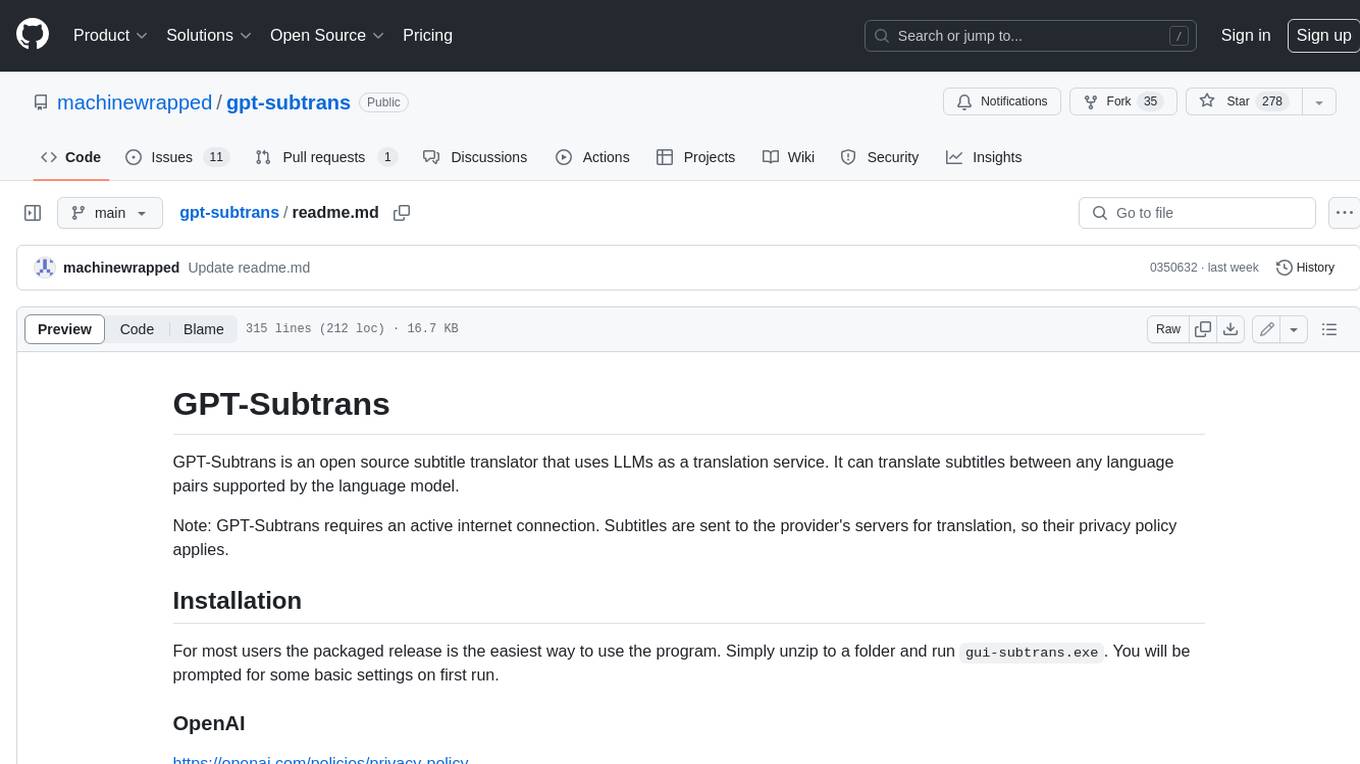
gpt-subtrans
GPT-Subtrans is an open-source subtitle translator that utilizes large language models (LLMs) as translation services. It supports translation between any language pairs that the language model supports. Note that GPT-Subtrans requires an active internet connection, as subtitles are sent to the provider's servers for translation, and their privacy policy applies.
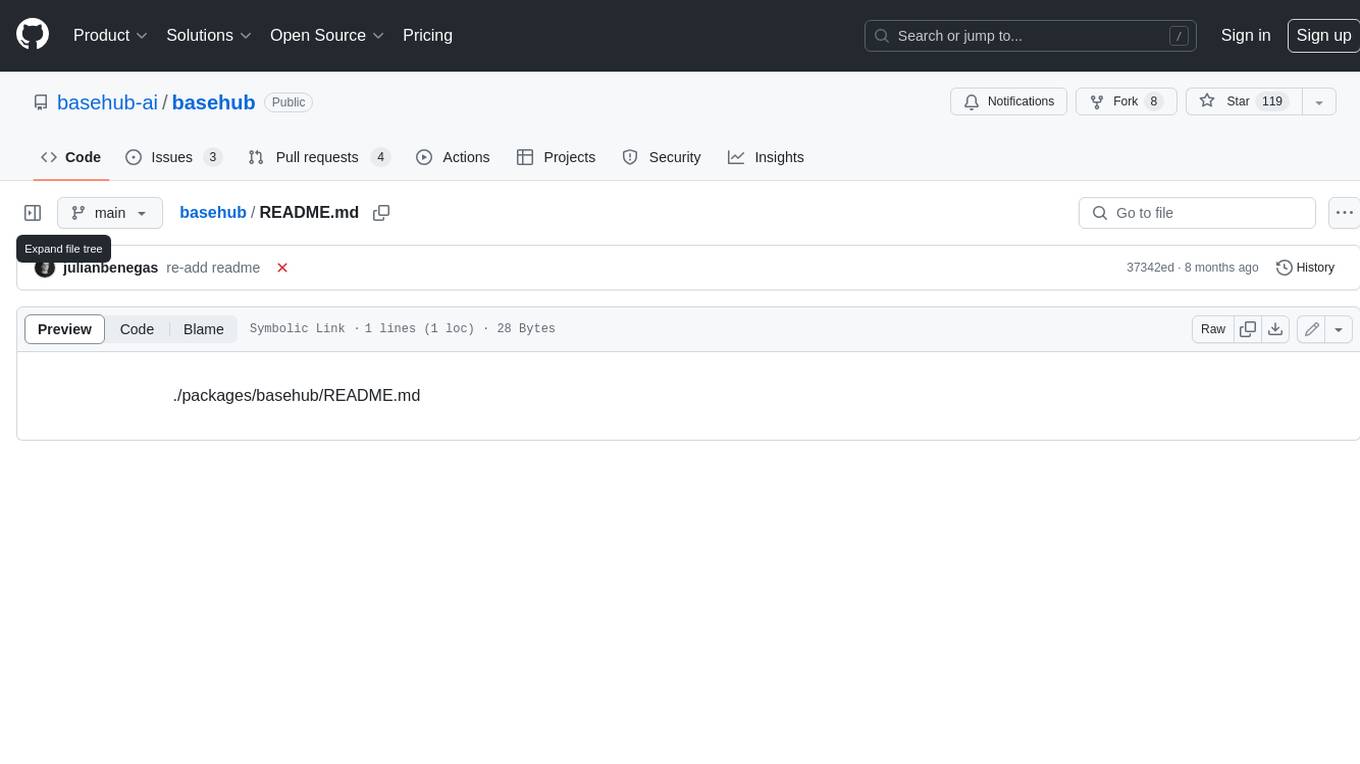
basehub
JavaScript / TypeScript SDK for BaseHub, the first AI-native content hub. **Features:** * ✨ Infers types from your BaseHub repository... _meaning IDE autocompletion works great._ * 🏎️ No dependency on graphql... _meaning your bundle is more lightweight._ * 🌐 Works everywhere `fetch` is supported... _meaning you can use it anywhere._
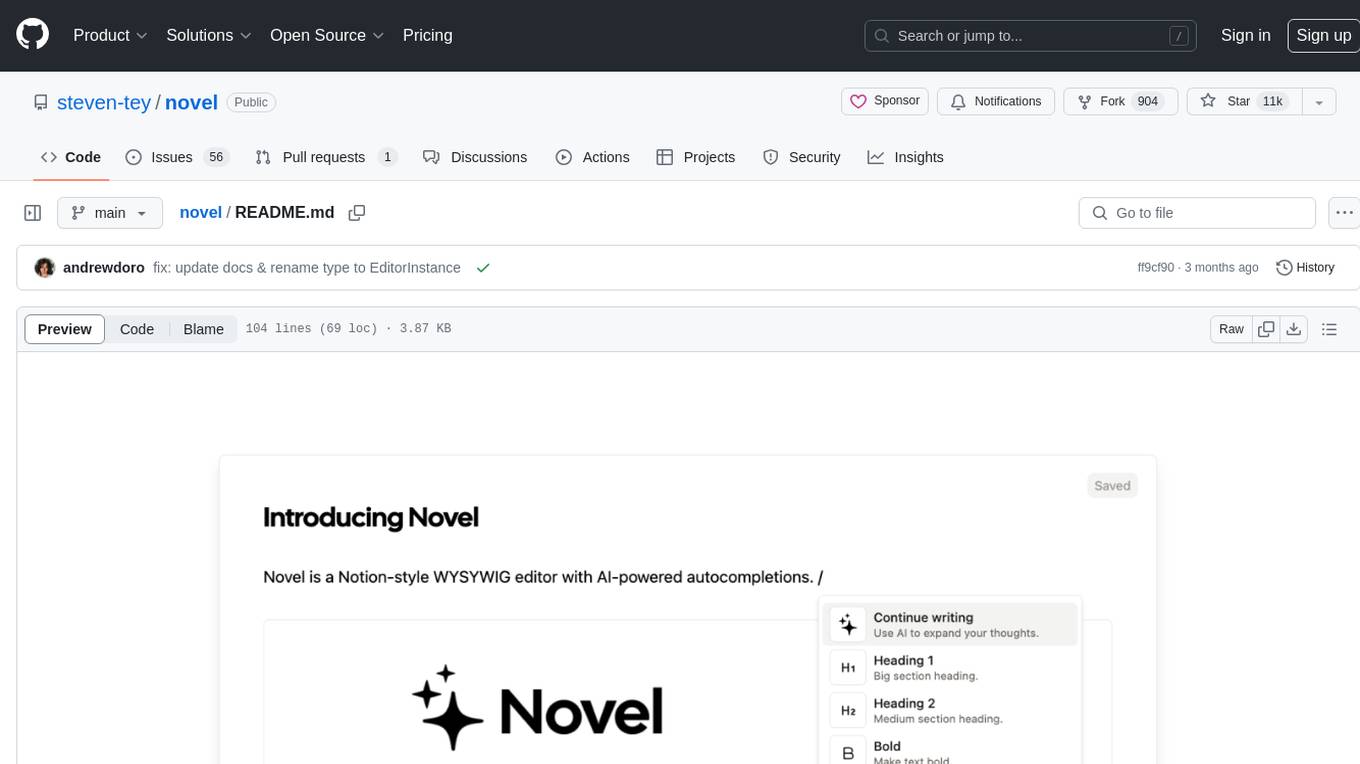
novel
Novel is an open-source Notion-style WYSIWYG editor with AI-powered autocompletions. It allows users to easily create and edit content with the help of AI suggestions. The tool is built on a modern tech stack and supports cross-framework development. Users can deploy their own version of Novel to Vercel with one click and contribute to the project by reporting bugs or making feature enhancements through pull requests.
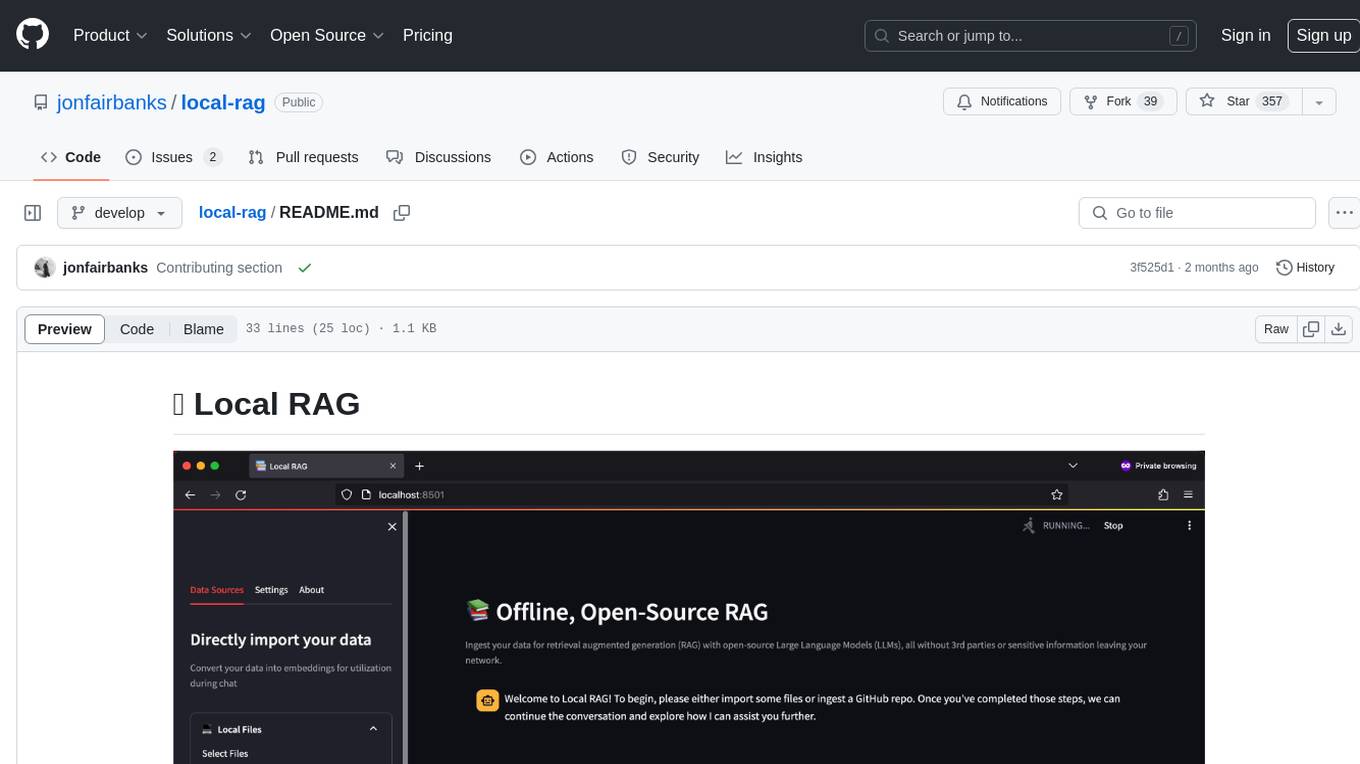
local-rag
Local RAG is an offline, open-source tool that allows users to ingest files for retrieval augmented generation (RAG) using large language models (LLMs) without relying on third parties or exposing sensitive data. It supports offline embeddings and LLMs, multiple sources including local files, GitHub repos, and websites, streaming responses, conversational memory, and chat export. Users can set up and deploy the app, learn how to use Local RAG, explore the RAG pipeline, check planned features, known bugs and issues, access additional resources, and contribute to the project.
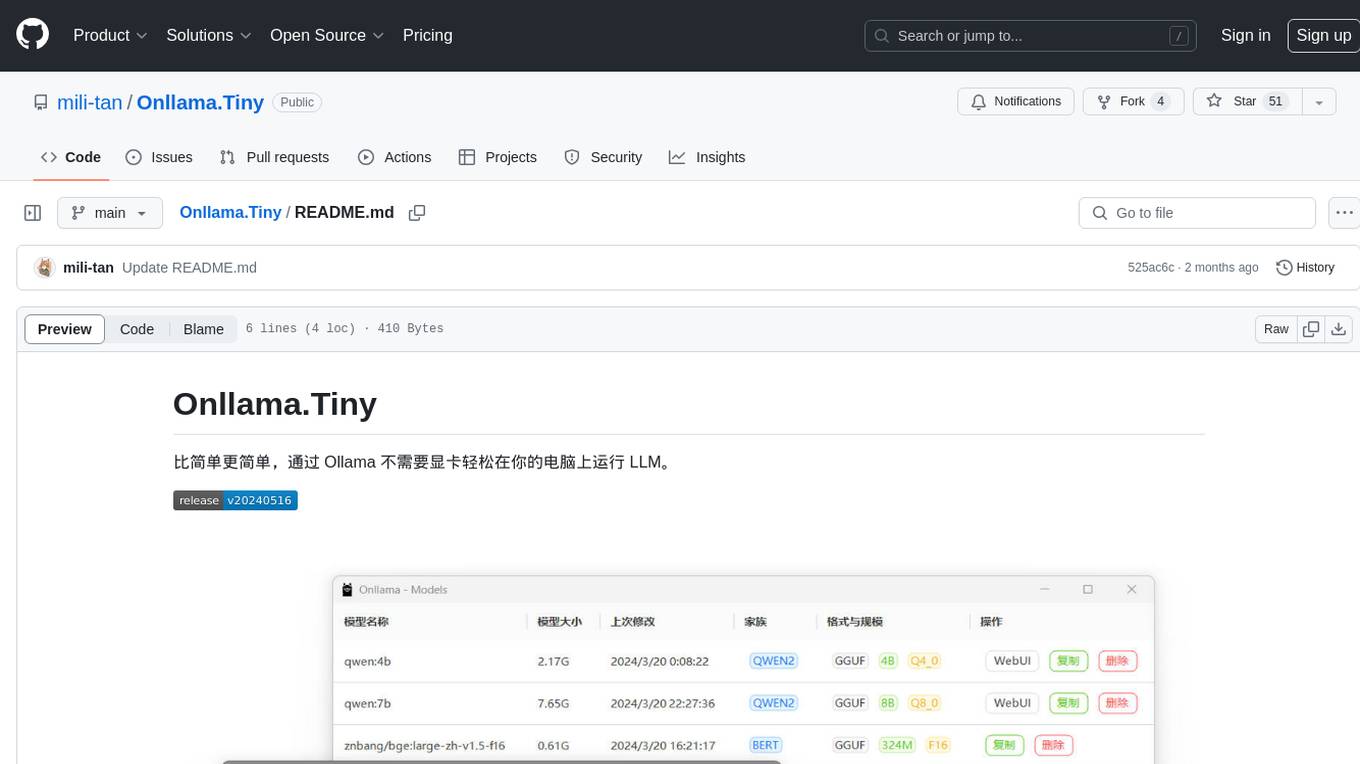
Onllama.Tiny
Onllama.Tiny is a lightweight tool that allows you to easily run LLM on your computer without the need for a dedicated graphics card. It simplifies the process of running LLM, making it more accessible for users. The tool provides a user-friendly interface and streamlines the setup and configuration required to run LLM on your machine. With Onllama.Tiny, users can quickly set up and start using LLM for various applications and projects.
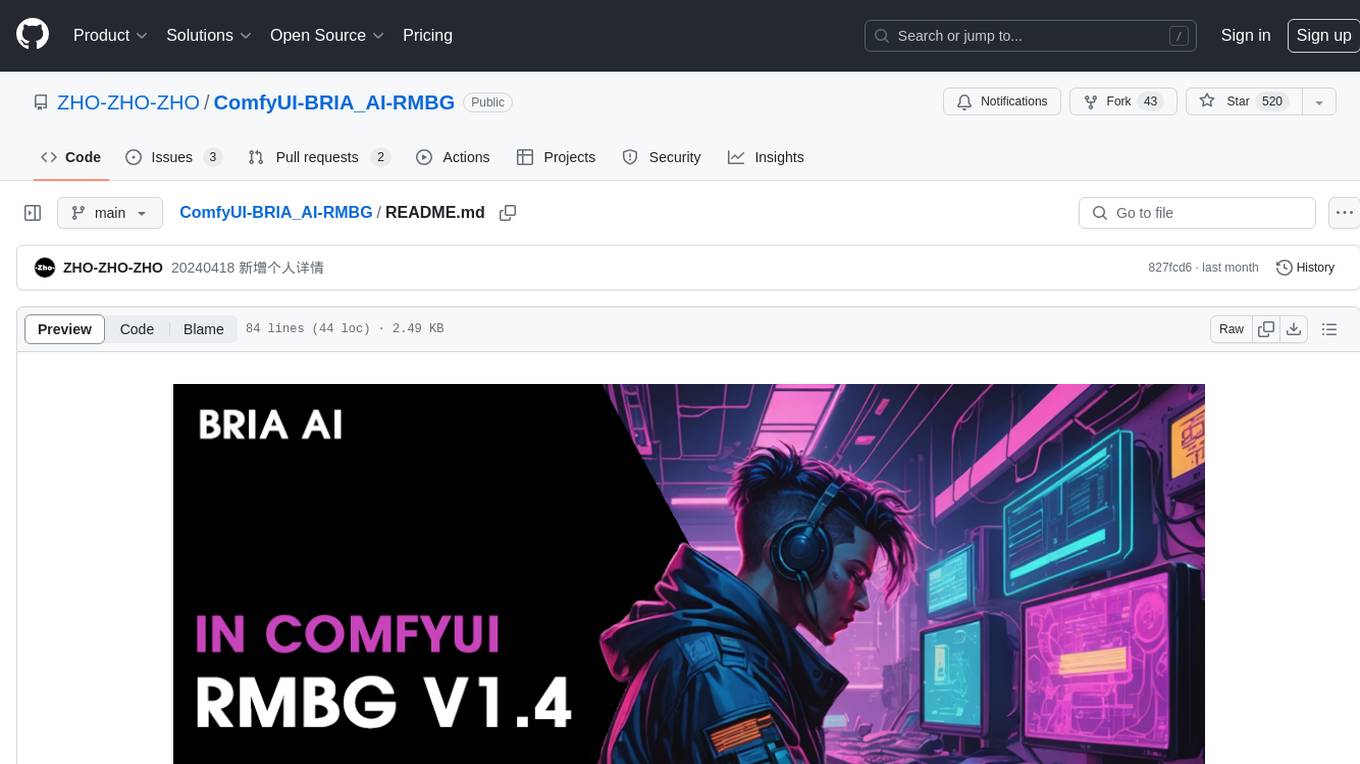
ComfyUI-BRIA_AI-RMBG
ComfyUI-BRIA_AI-RMBG is an unofficial implementation of the BRIA Background Removal v1.4 model for ComfyUI. The tool supports batch processing, including video background removal, and introduces a new mask output feature. Users can install the tool using ComfyUI Manager or manually by cloning the repository. The tool includes nodes for automatically loading the Removal v1.4 model and removing backgrounds. Updates include support for batch processing and the addition of a mask output feature.
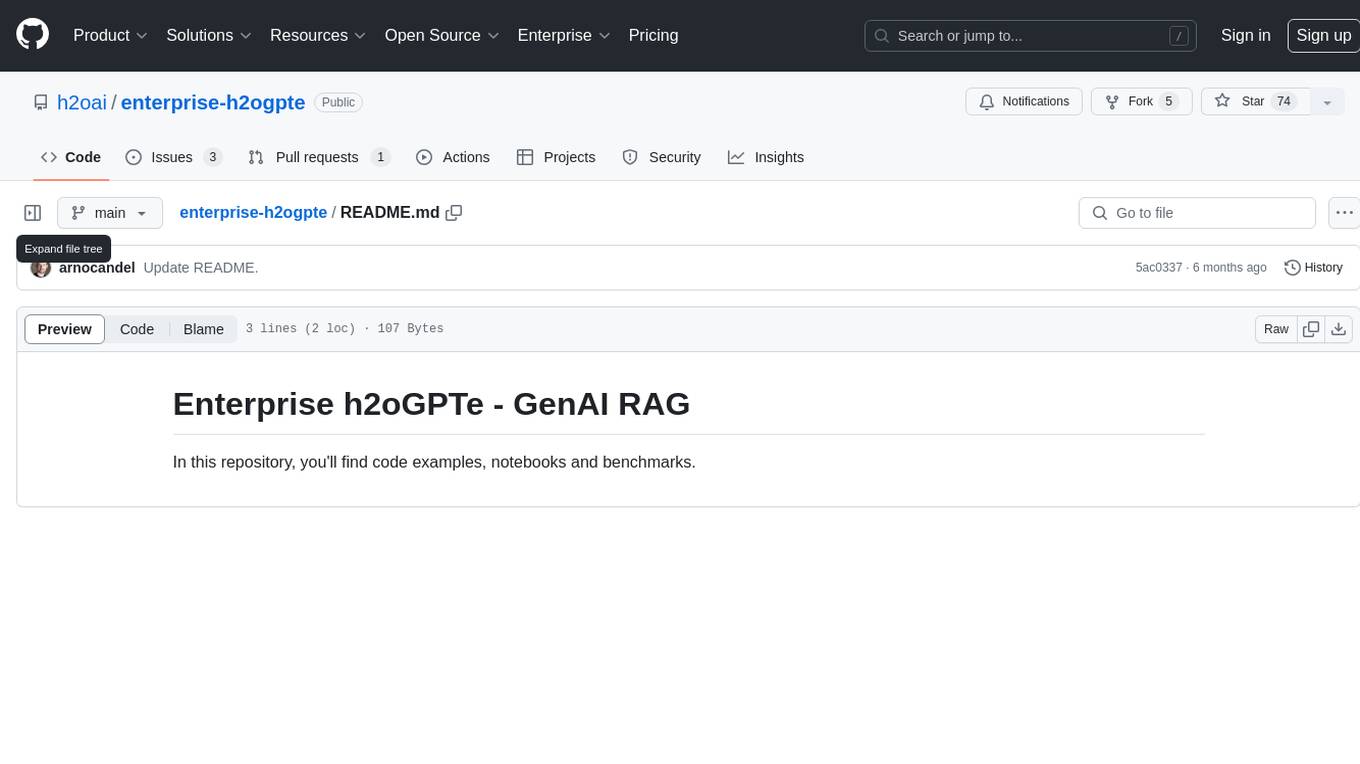
enterprise-h2ogpte
Enterprise h2oGPTe - GenAI RAG is a repository containing code examples, notebooks, and benchmarks for the enterprise version of h2oGPTe, a powerful AI tool for generating text based on the RAG (Retrieval-Augmented Generation) architecture. The repository provides resources for leveraging h2oGPTe in enterprise settings, including implementation guides, performance evaluations, and best practices. Users can explore various applications of h2oGPTe in natural language processing tasks, such as text generation, content creation, and conversational AI.
For similar jobs
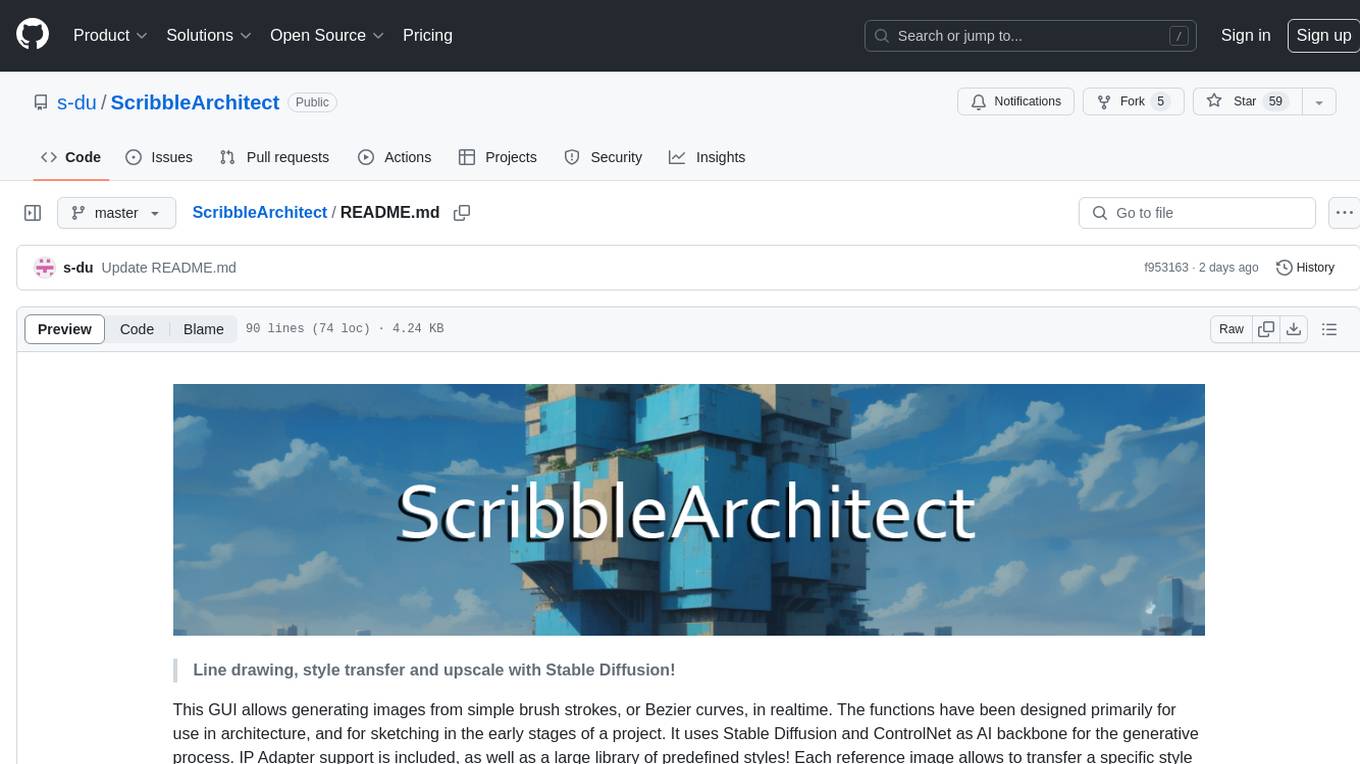
ScribbleArchitect
ScribbleArchitect is a GUI tool designed for generating images from simple brush strokes or Bezier curves in real-time. It is primarily intended for use in architecture and sketching in the early stages of a project. The tool utilizes Stable Diffusion and ControlNet as AI backbone for the generative process, with IP Adapter support and a library of predefined styles. Users can transfer specific styles to their line work, upscale images for high resolution export, and utilize a ControlNet upscaler. The tool also features a screen capture function for working with external tools like Adobe Illustrator or Inkscape.

PAI
PAI is an open-source personal AI infrastructure designed to orchestrate personal and professional lives. It provides a scaffolding framework with real-world examples for life management, professional tasks, and personal goals. The core mission is to augment humans with AI capabilities to thrive in a world full of AI. PAI features UFC Context Architecture for persistent memory, specialized digital assistants for various tasks, an integrated tool ecosystem with MCP Servers, voice system, browser automation, and API integrations. The philosophy of PAI focuses on augmenting human capability rather than replacing it. The tool is MIT licensed and encourages contributions from the open-source community.
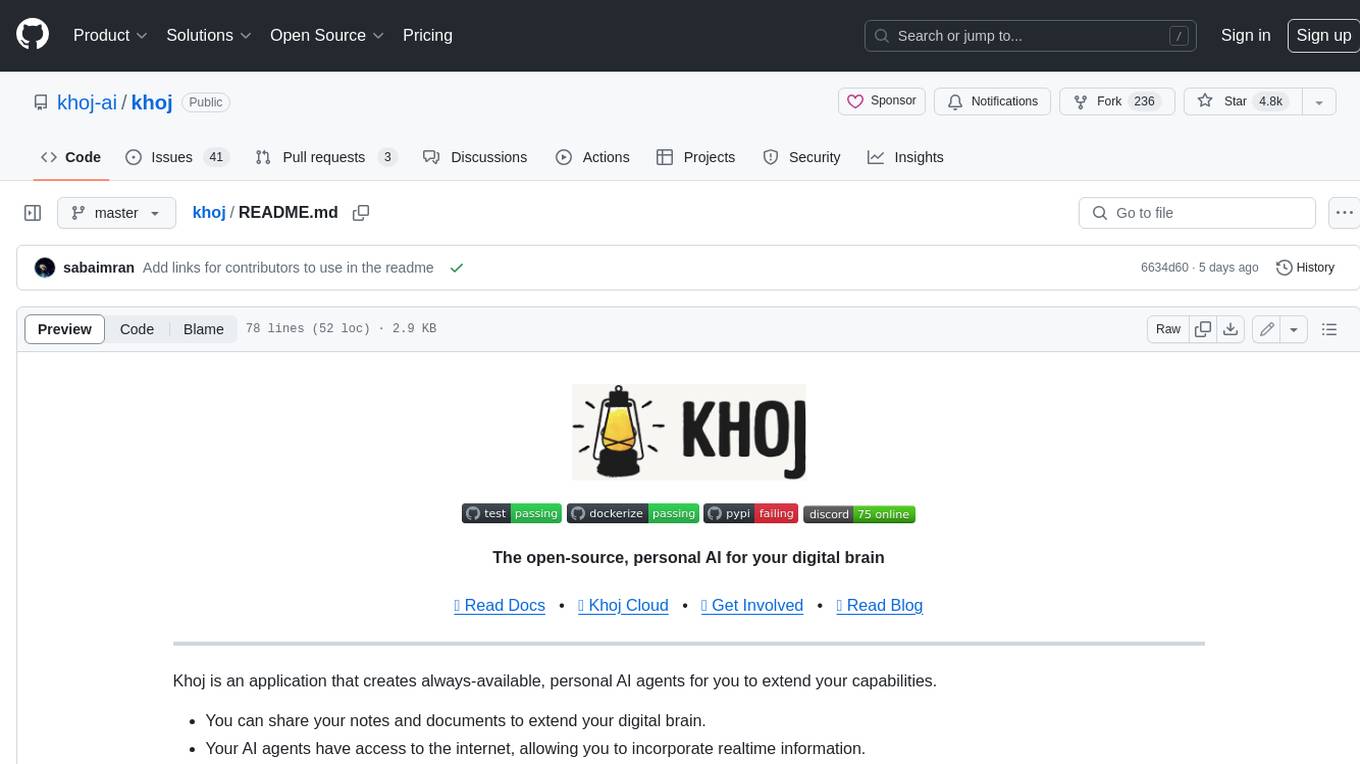
khoj
Khoj is an open-source, personal AI assistant that extends your capabilities by creating always-available AI agents. You can share your notes and documents to extend your digital brain, and your AI agents have access to the internet, allowing you to incorporate real-time information. Khoj is accessible on Desktop, Emacs, Obsidian, Web, and Whatsapp, and you can share PDF, markdown, org-mode, notion files, and GitHub repositories. You'll get fast, accurate semantic search on top of your docs, and your agents can create deeply personal images and understand your speech. Khoj is self-hostable and always will be.
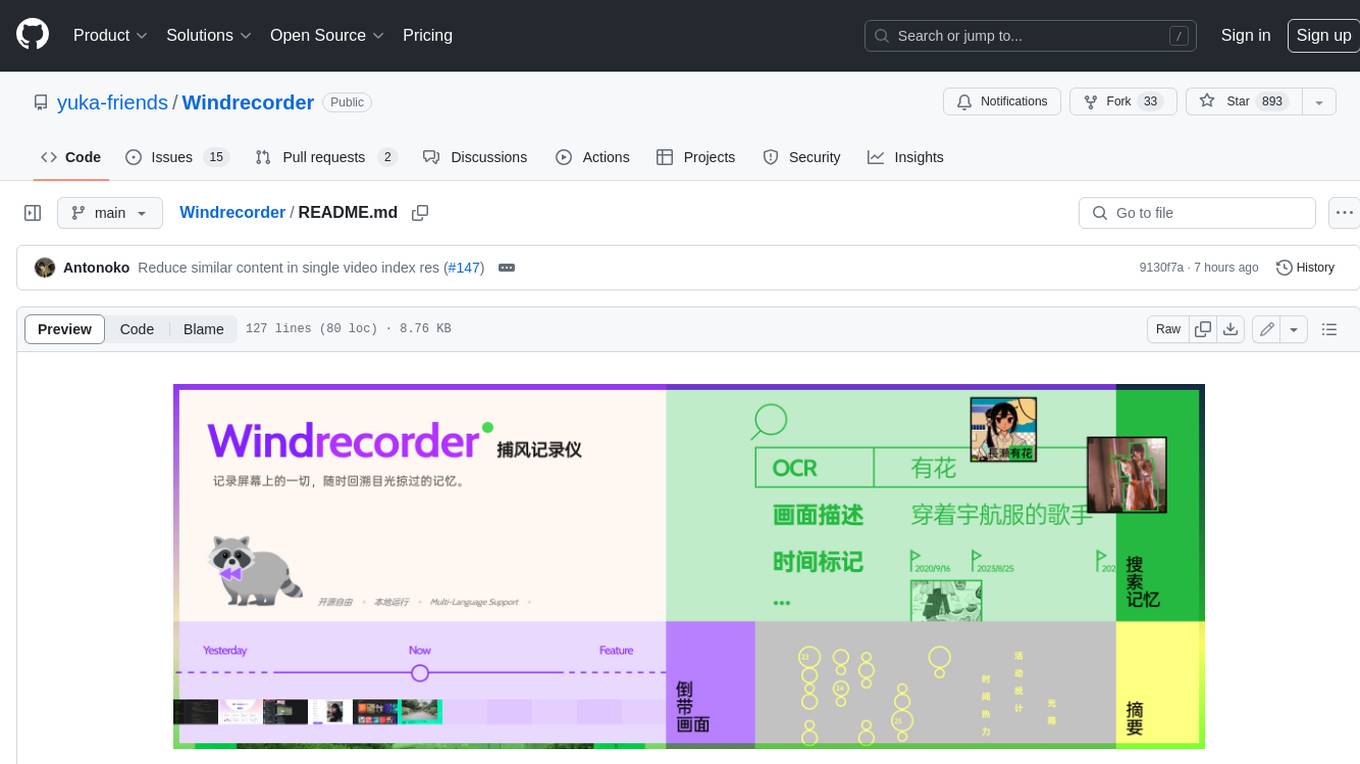
Windrecorder
Windrecorder is an open-source tool that helps you retrieve memory cues by recording everything on your screen. It can search based on OCR text or image descriptions and provides a summary of your activities. All of its capabilities run entirely locally, without the need for an internet connection or uploading any data, giving you complete ownership of your data.
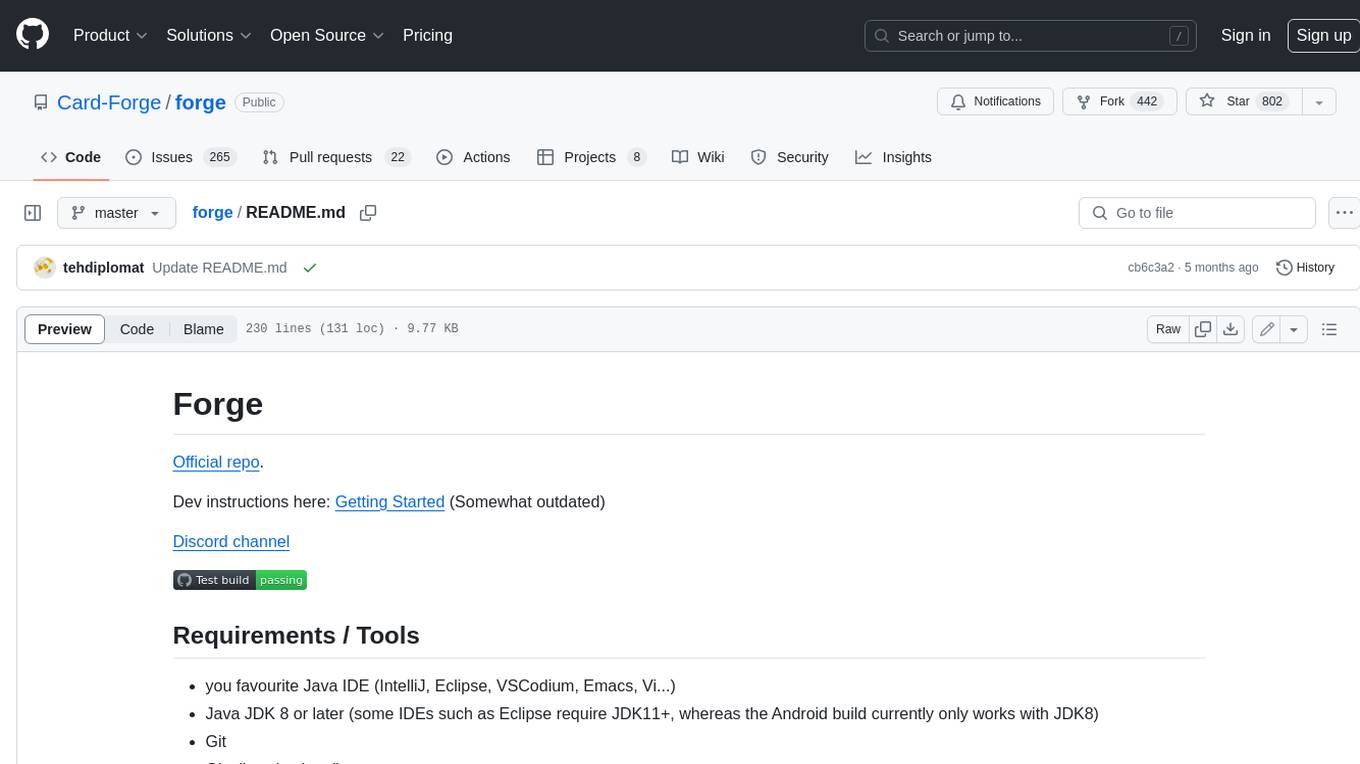
forge
Forge is a free and open-source digital collectible card game (CCG) engine written in Java. It is designed to be easy to use and extend, and it comes with a variety of features that make it a great choice for developers who want to create their own CCGs. Forge is used by a number of popular CCGs, including Ascension, Dominion, and Thunderstone.
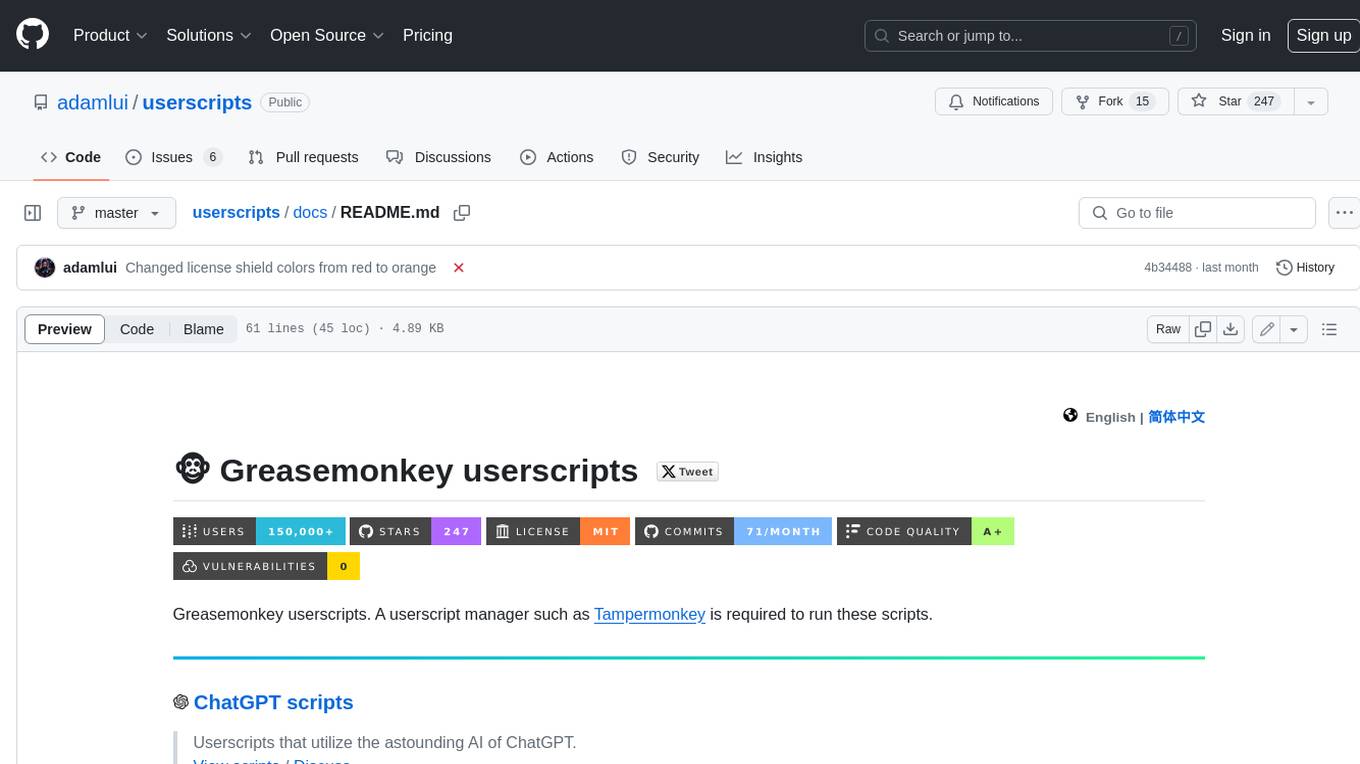
userscripts
Greasemonkey userscripts. A userscript manager such as Tampermonkey is required to run these scripts.
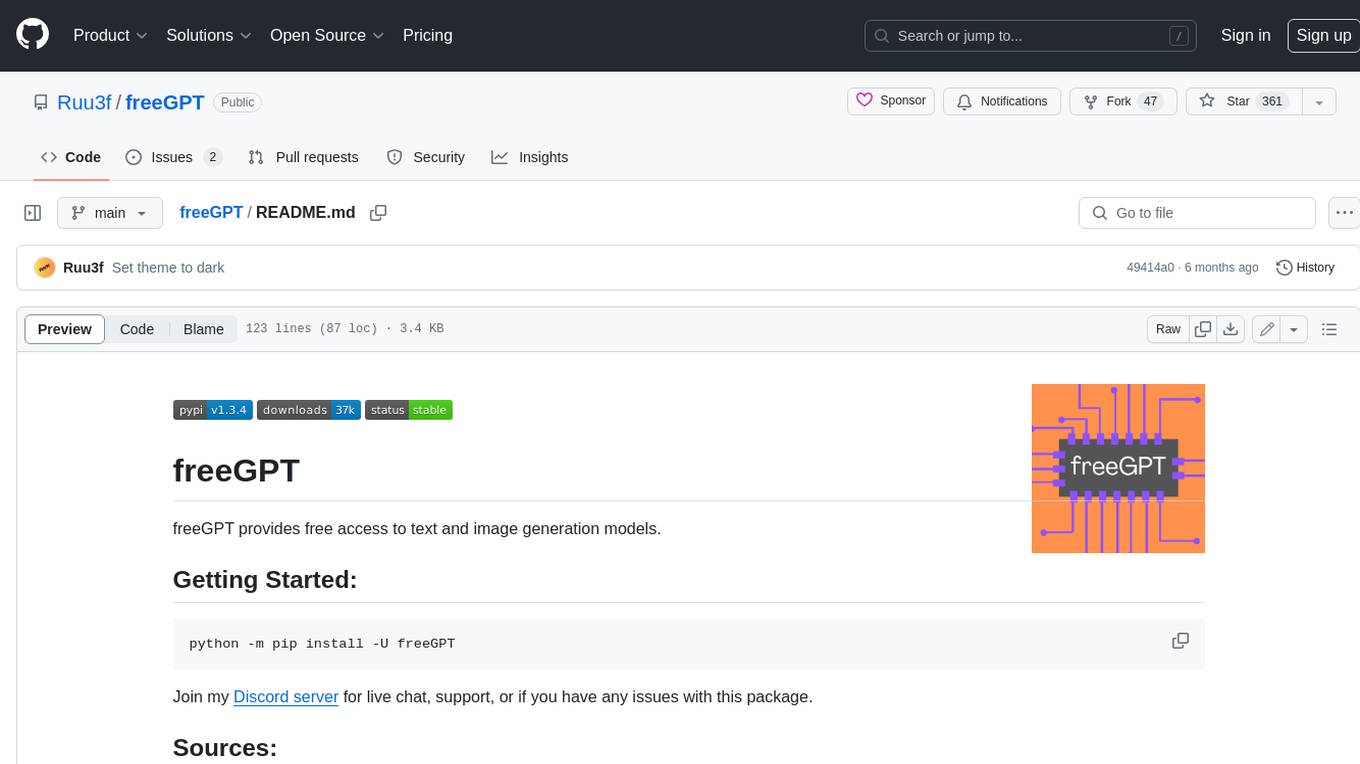
freeGPT
freeGPT provides free access to text and image generation models. It supports various models, including gpt3, gpt4, alpaca_7b, falcon_40b, prodia, and pollinations. The tool offers both asynchronous and non-asynchronous interfaces for text completion and image generation. It also features an interactive Discord bot that provides access to all the models in the repository. The tool is easy to use and can be integrated into various applications.
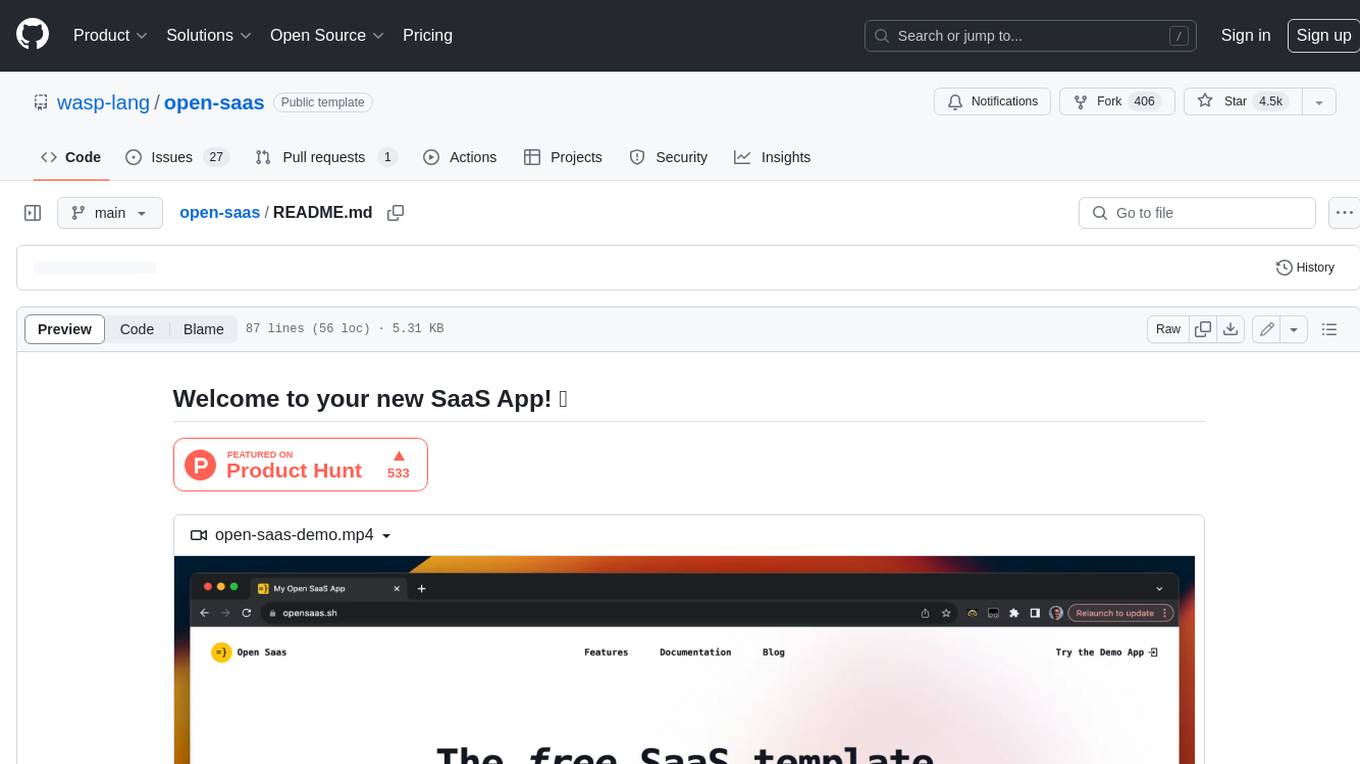
open-saas
Open SaaS is a free and open-source React and Node.js template for building SaaS applications. It comes with a variety of features out of the box, including authentication, payments, analytics, and more. Open SaaS is built on top of the Wasp framework, which provides a number of features to make it easy to build SaaS applications, such as full-stack authentication, end-to-end type safety, jobs, and one-command deploy.











